Outforia Quicktake: Key Takeaways
- Ducks have various physical features that help with identification, such as their crown, bill, nail, throat, auriculars, wing, breast, rump, and tail.
- There are three main groups of duck species: dabbling ducks, diving ducks, and perching ducks, each with their own unique characteristics and behaviors.
- Ducks go through a life cycle that includes the egg, hatchling, and adult stages, with ducklings learning to forage and hunt from their mothers.
- Ducks have various interesting facts, such as their worldwide presence (except Antarctica), waterproof feathers, and a wide range of noises, including quacking and whistling.
- Ducks have numerous natural predators, including red foxes, raccoons, skunks, coyotes, badgers, mink, corvids, and gulls.
The Physical Features of Ducks
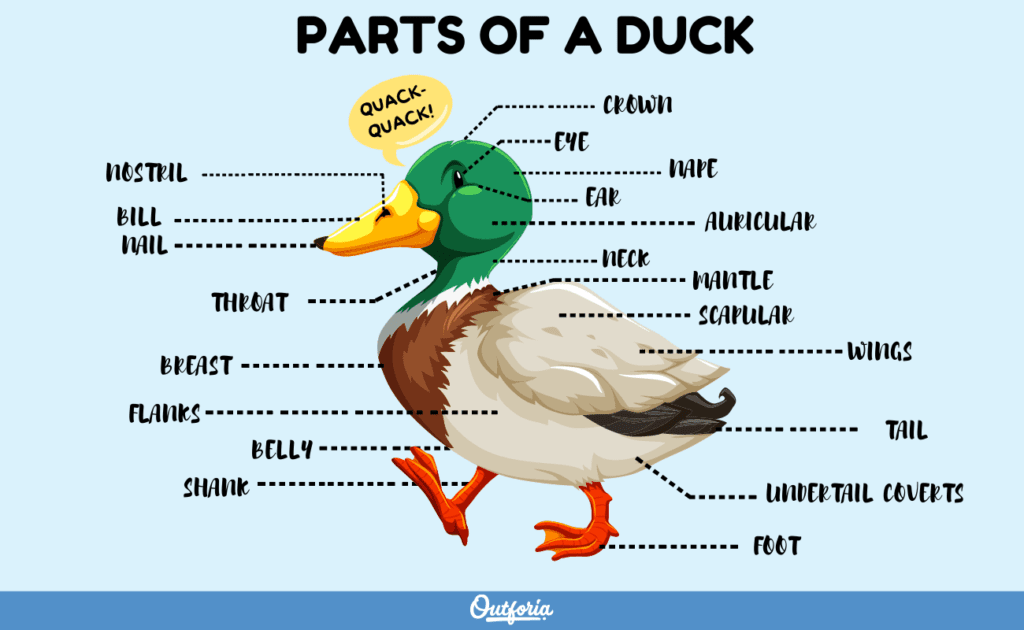
Share this image on your site
<a href="https://outforia.com/types-of-ducks/"><img style="width:100%;" src="https://outforia.com/wp-content/uploads/2021/12/PARTS-OF-A-DUCK-1024x630.png"></a><br>Part of a duck by <a href="https://outforia.com">Outforia</a>Understanding the physical features of species of ducks helps outdoor nature enthusiasts and birders identify ducks quickly and accurately.
Crown – Just like humans., the crown is the very top of the head. The crown of a duck’s head can help identify a duck based on whether it is flatter or more peaked.
Bill – A duck’s bill is often spatula-shaped to help them filter their food from the water.
Nail – on the tip of the duck’s bill is a slightly thicker tip, called the nail. This helps with digging to find food.
Throat – The throat is noted on a duck when there is a prominent ring around the base of the duck’s neck.
Auriculars – The duck’s auriculars are the duck’s cheeks! Sometimes, there is distinctive coloring on the auriculars only.
Wing – The wings of a duck and the body of a duck can often be drastically different colors, which helps in identifying duck species.
Breast – Seen when the duck is flying, the breast of the duck may boast different colors, mottling, or distinct patterns.
Rump/Tail – While usually covered by wings, a duck’s rump can be helpful in identification. Dabbling ducks are the only ducks who stick their entire rear out of the water while feeding. Tail feathers can also help with identification, for example, mallard’s tail feathers are curled.
About All Ducks
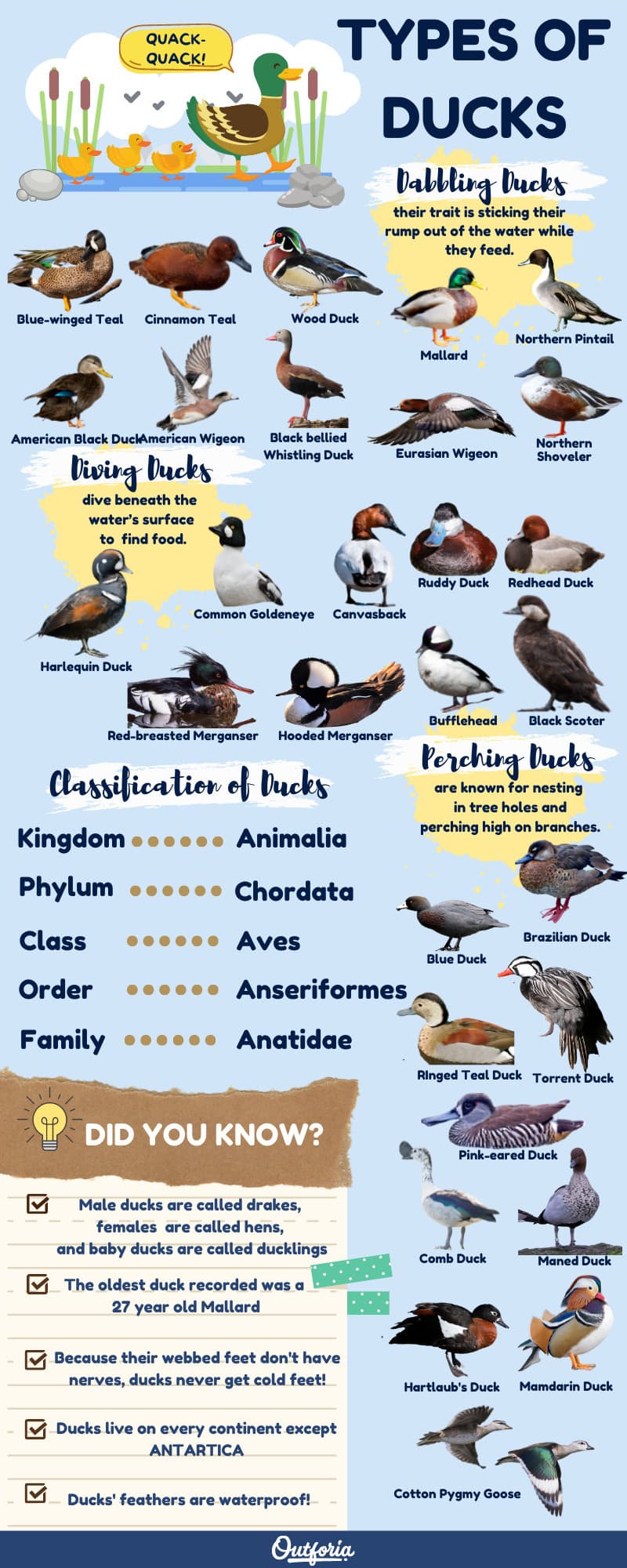
Share this image on your site
<a href="https://outforia.com/types-of-ducks/"><img style="width:100%;" src="https://outforia.com/wp-content/uploads/2021/12/Types-of-Ducks-Inforgraphics.jpg"></a><br>Types of Ducks Infographics by <a href="https://outforia.com">Outforia</a>When speaking of species of ducks, males are called drakes, females are called hens, and baby ducks are known as ducklings.
Hens typically find their mate during the winter months. The female duck then leads the male back to their breeding ground, traveling together in the spring. Typically, the female’s breeding ground is where the egg she came from hatched.
Hens lay and incubate the eggs, some drakes will guard their nest and chase away predators. Other drakes will not participate in any of the nesting processes and will instead continue migrating to their molting locations.
Drakes boast brilliant colors during mating season to attract the attention of hens. After breeding is over, many male ducks will molt and sport duller shades of brown and white until the following year. On the other hand, female ducks are always more boring in color and are often brown. Female coloring is designed to hide the hens better while brooding and taking care of hatchlings.
You may also like: How Do Ducks Mate? It’s Weirder Than You Think
3 Main Groups of Duck Species
1. Dabbling Duck
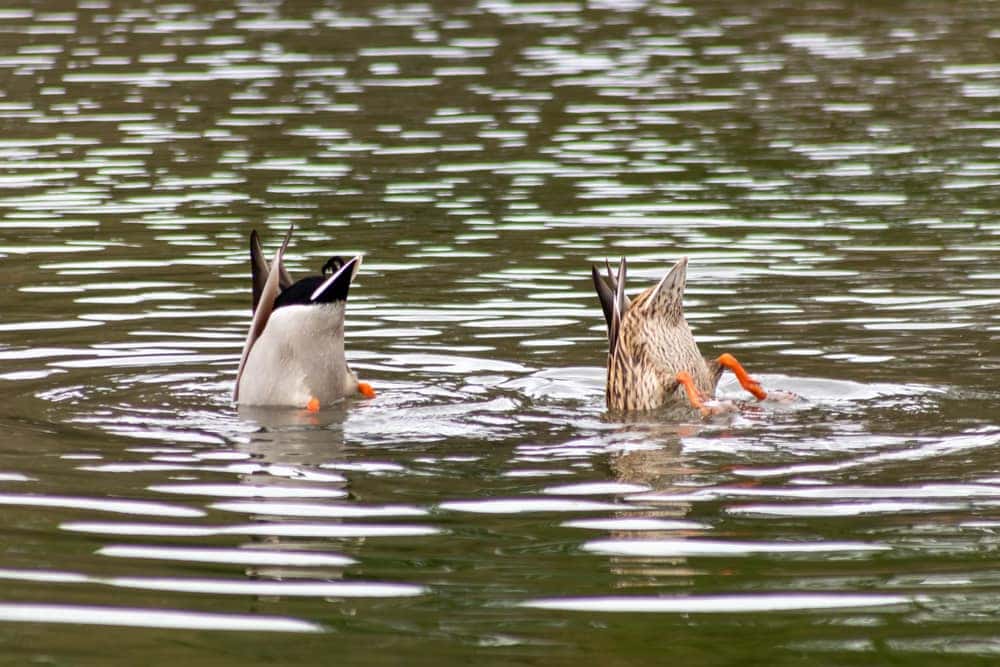
Dabbling ducks are easily recognizable by their trait of sticking their rump out of the water while they feed. Dabbling ducks are also called dipping, surface-feeding, or freshwater ducks. There are about 38 species of dabbling ducks.
These types of ducks mainly feed on water plants, seeds, and insects. These ducks root through mud and water in shallow water to find insects and skim the top of the water for food. Dabbling ducks rarely submerge themselves underwater. You can spot dabbling ducks leaving the water with their flock noisily.
You can find Dabbling ducks in worldwide inland waters of the Northern Hemisphere.
Female dabbling ducks are responsible for laying and incubating 6-12 eggs for 20-25 days. Once the eggs hatch, birdlings can fly within two weeks.
Types of Dabbling Ducks
American Black Duck
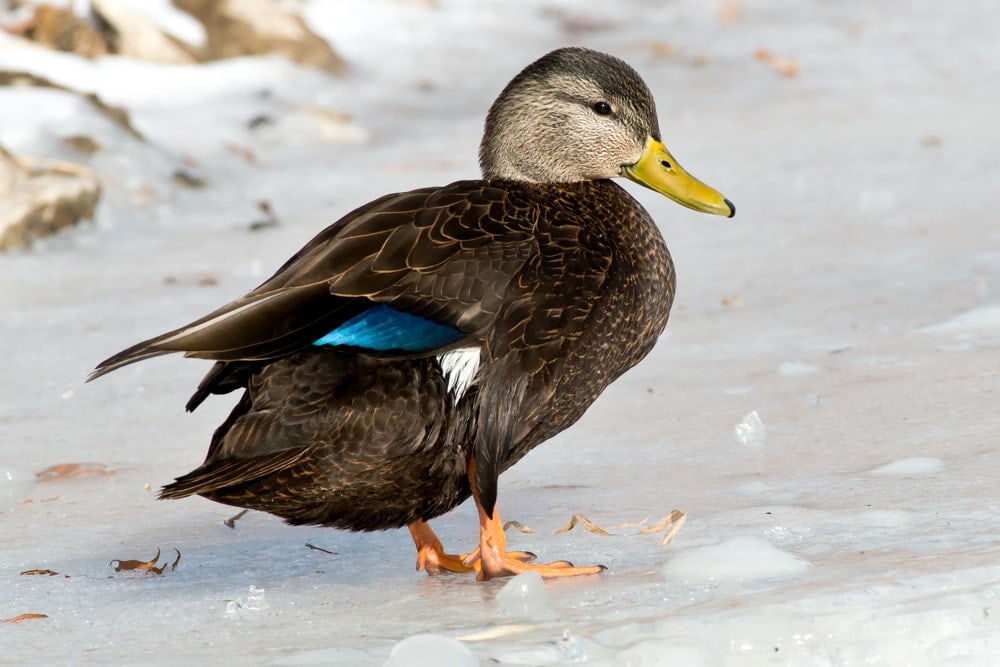
You can find American black ducks in the northern United States, from the Mississippi River to Ontario. The highest densities of the ducks are in Maine and Nova Scotia during mating seasons. Year-round, you can find black ducks in the northeast states.
When American black ducks winter, they move to the south from the Maritime Provinces to Florida. During wintering, you can spot these ducks in large numbers between Long Island and North Carolina.
Marshes, bogs, lakes, stream margins, brackish and salt marshes, and the margins of estuaries are all locations where you will find American black ducks.
American black ducks will eat insects and amphibians in freshwater habitats and mollusks and crustaceans in brackish water.
American black ducks have a dark plumage but are similar to mallards in size and color. The male and female are parallel except for their bill. Males have a yellow bill, while females have a dull green bill. In-flight, you can spot the ducks’ white underwings along with their brown heads, compared to very dark bodies.
American Wigeon
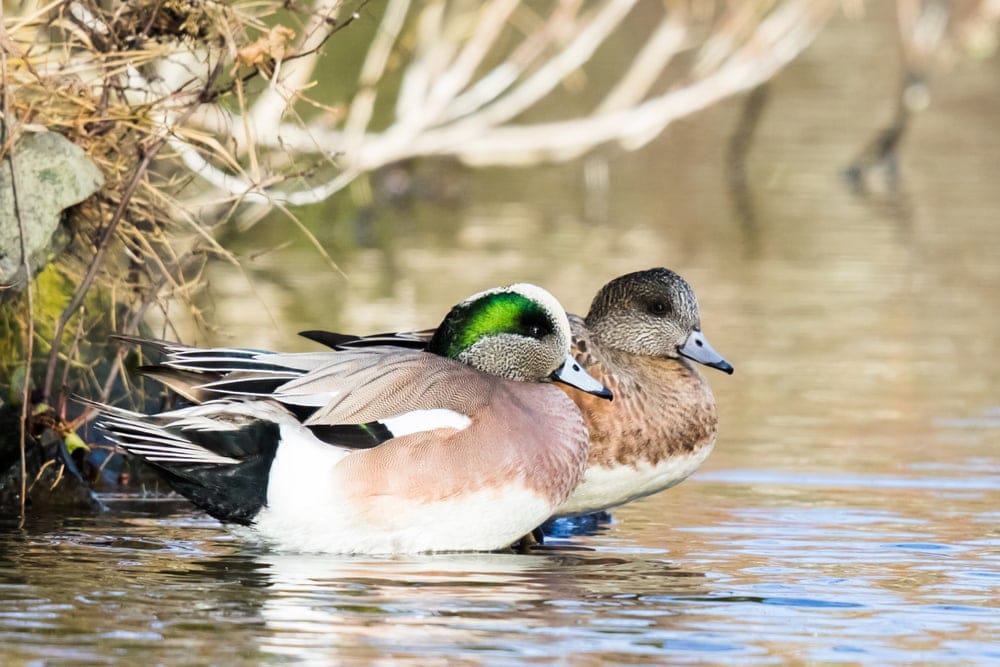
American Wigeons breed in the most Northwest parts of Canada in Alberta, Manitoba, and Saskatchewan. You can find Wigeons in Alaska as well. When not breeding, American wigeons winter to the south to Florida, Texas, and Mexico. These ducks are one of the earliest species to migrate to their wintering grounds.
Both drakes and hens have rounded compact heads. Drakes are easily identifiable by a green stripe above and behind their eye with a white crown. Males also have a distinctive matching green line on their wings when in flight. Hens have dark smudges around their eyes.
Whether in the tundras of Canada or California, American Wigeons prefer wet meadows, wetlands, and flooded pastures for their foraging of grasses and sedges.
Blue-winged Teal
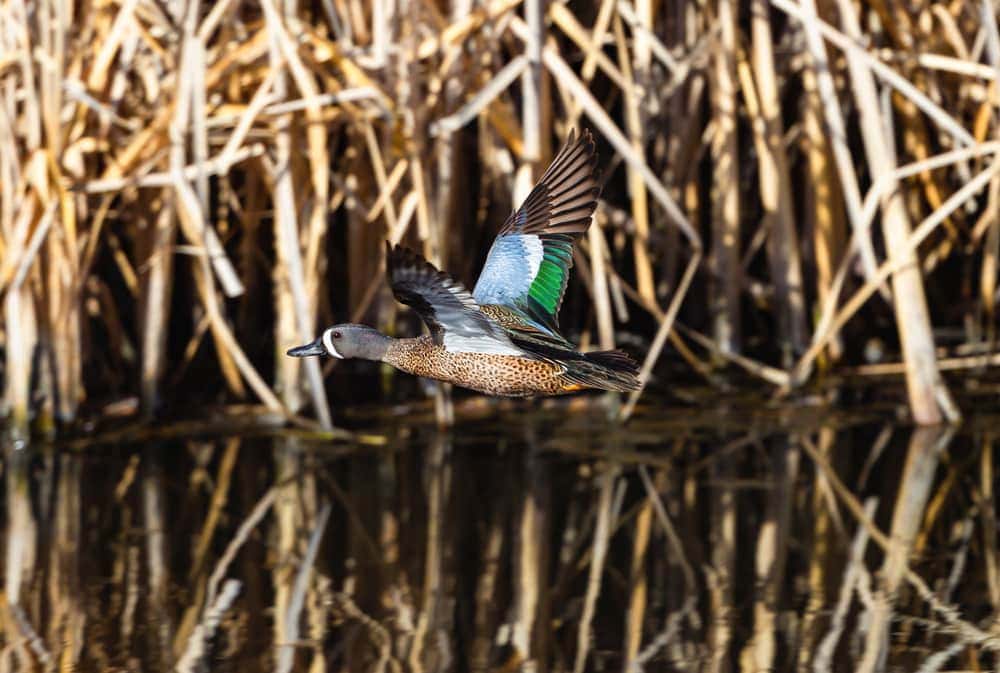
Small in size, the blue-winged teal duck can be identified by its brown-colored body and dense black speckles. As its name suggests, blue-winged teal males have two powder blue patches on their wings in flight. Another identifying factor for males is their bluish-gray heads and a white crescent shape in front of their eyes. Females are brown with a dark, darker crown and black bill.
In the Prairie Pothole Region, you can find the blue-winged teals in their breeding grounds in central North America. While interesting, Blue-winged teals migrate to Florida, Mexico, Central, and South America.
Blue-winged teals prefer wetlands and areas such as shallow marshes, flooded ditches, and ponds. Females lay an average of 10 eggs each year and nest in tall grasses.
Reportedly, blue-winged teals migrate over vast distances. One recording tracked a bird from Alberta to Venezuela in just a month. The blue-winged teal duck is one of the last ducks to migrate in spring and fall.
Cinnamon Teal
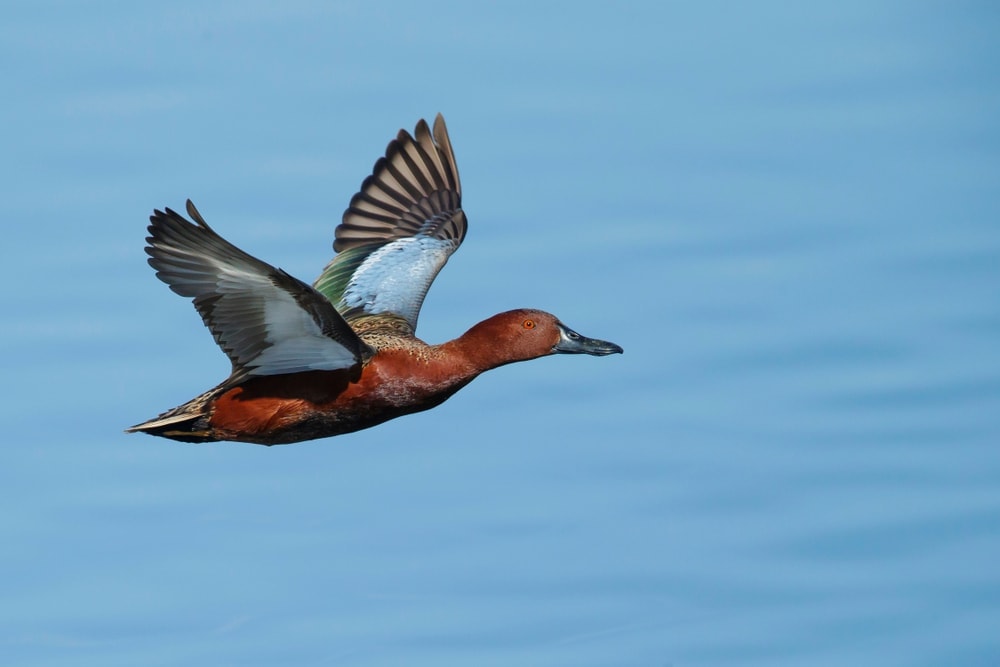
In the western United States, the cinnamon teal duck breeds in alkaline wetlands and winter in Mexico and Central America. Occasionally, you will spot cinnamon teal ducks in Colombia and Venezuela. You will see cinnamon teal ducks migrating in Utah’s Great Salt Lake marshes and the Central Valley of California.
Typically, cinnamon teal ducks inhabit freshwater wetlands, such as marshes. They prefer plenty of vegetation and high plants to nest. Females lay 8-10 eggs per year. Much like other dabbling ducks, cinnamon teals eat aquatic insects and mollusks. They do, however, prefer salt grass seeds, pondweed seeds, and rush seeds.
While hens look similar to Blue-winged teal females, cinnamon teal drakes have highly distinctive characteristics. A male cinnamon teal has a cinnamon-red head, neck, breast, and belly during mating season. After breeding is complete, males molt this coloring and look much more like female birds. During this season, you can tell males apart by their bright red eyes and their flatter beaks.
Eurasian Wigeon
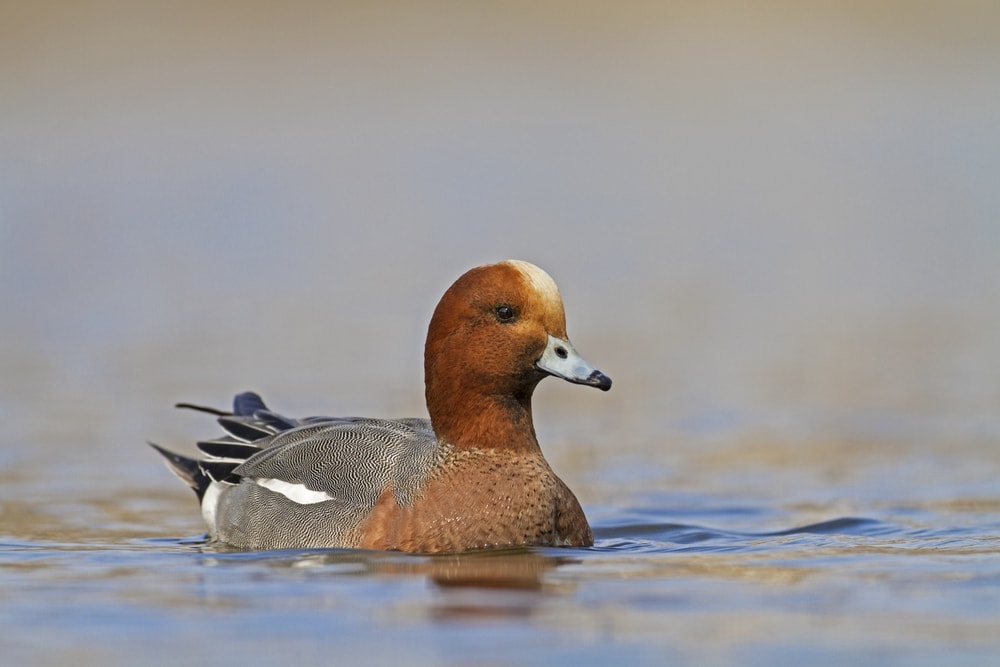
During breeding seasons, Eurasian wigeons live in Scandinavia, the British Isles, Iceland, eastern Siberia, and northern Europe. Eurasian wigeons winter in Africa, Arabia, India, southern China, the east Atlantic islands, and the Philippines.
Eurasian Wigeons breed in shallow wetlands and freshwater marshes, ponds, and lakes, surrounded by forests and tundras. Females lay an average of 7-10 eggs, preferring to nest on the ground of said forest or tundra.
Adult males have a mainly gray body with a large white patch on their wings. In contrast, their heads are chestnut colored. Females are round-headed with a short bill. Their bodies are mainly brown to dark brown wings. When in flight, females have a white under-wing. Both drakes and hens have a black tip to their bill.
Northern Pintail
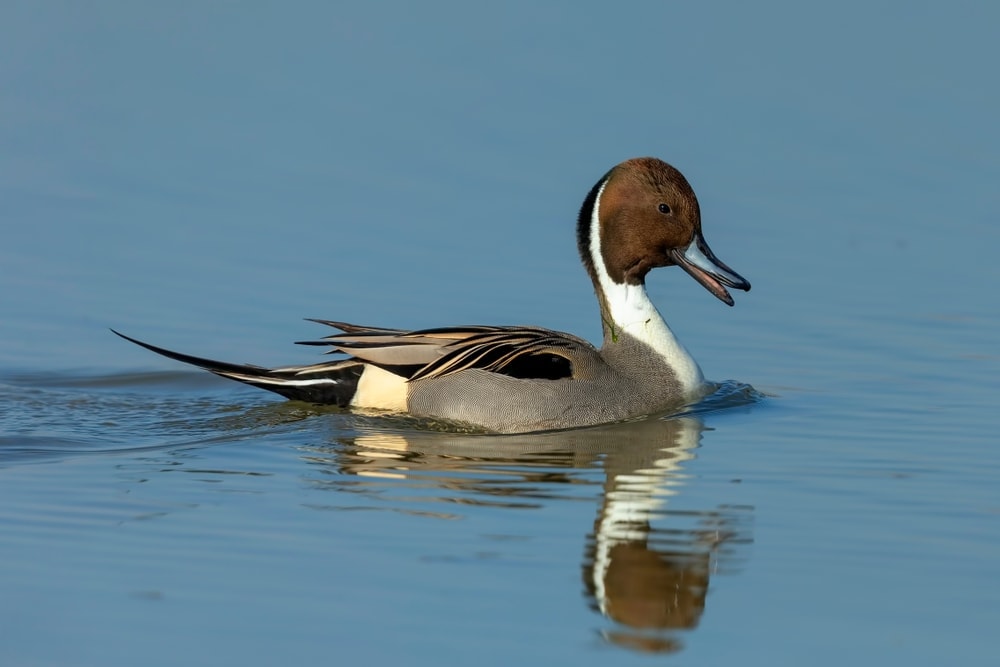
Northern pintails breed in the north of the United States and into Canada, staying in shallow waters around the edges of lakes and ponds, far away from human activity. These ducks winter in the central and southern United States and into Mexico.
Unlike many other ducks, the Northern pintail is excellent at walking on land and is often seen in farm fields foraging for seeds. These agile birds are also incredible fliers, reaching speeds up to 48 mph (77.24 kph). They’ve also migrated non-stop for over 1,500 miles (2,414.01 km)!
Northern pintails prefer to breed in wetlands with short vegetation and nearby crop fields. Northern pintails nest on the ground in between the greenery. They make several scrapes on the ground before nesting. Also, you might spot them in brackish wetlands, estuaries, and bays. They eat the seeds and grains from farm fields, along with aquatic plants, worms, and other aquatic insects.
Male northern pintails have long necks, which exaggerates their long tail feathers. They have a dark brown head, white breast, and a white neck stripe. Females are also slender with long tail feathers but less boisterous in color. Females sport a tan head, as opposed to most females’ brown heads.
Wood Duck
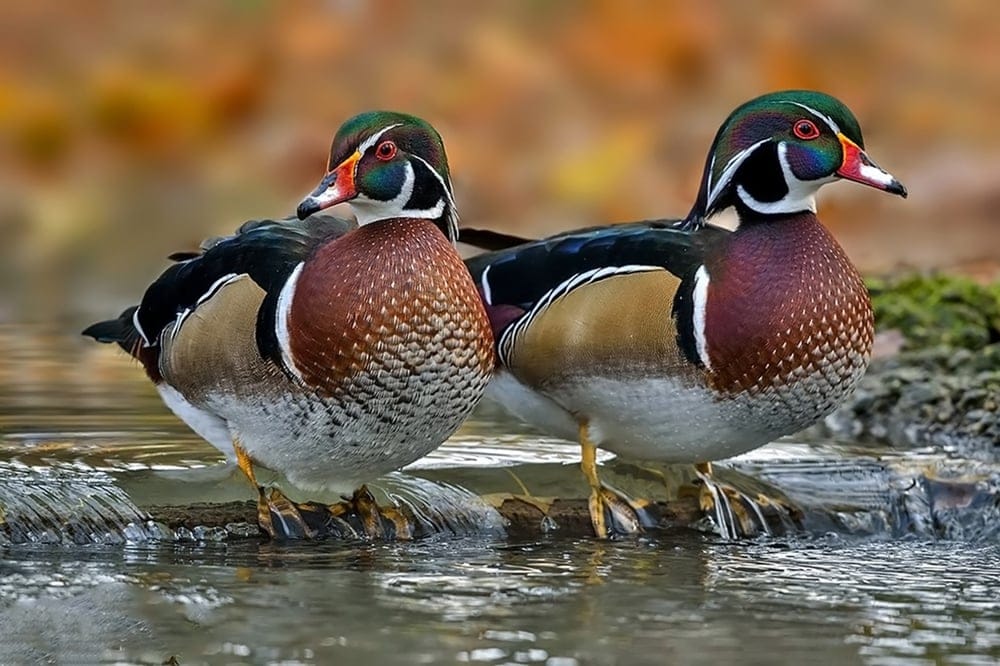
Wood ducks live through the central and eastern United States, into Canada, and along the Pacific coast. Recently, breeding patterns of the wood duck have traveled into the Great Plains region. Not many wood ducks winter, but those who do fly to eastern Texas.
Like their name suggests Wood ducks like wooded swamps, bottomland forests, beaver ponds, and freshwater marshes. Wood ducks prefer areas with lots of vegetation coverage that they can easily hide in.
Wood ducks eat seeds, fruits, and insects. Because they are typically in wooded areas, wood ducks can also feed on acorns and other fruits from forest trees.
The nests of wood ducks are found in tree cavities 1-2 feet (0.30 m-0.60 m) in diameter and anywhere from 2-60 feet (0.60 m-18.28 m) high. For the protection of the nests, higher sites seem to be preferred. Wood ducks can not make their cavities in trees and rely on the natural state of tree decay for their nests. Females lay 2-16 eggs 1-2 times each year.
Male wood ducks are gorgeous with distinctive plumage. A green crested head and chestnut body are accented with white and black markings on the neck, jaw, and wings. Male ducks have piercing red eyes. Females are a warm brown with a crested head, a white teardrop shape around the eye and wings with white and blue plumage.
Mallard
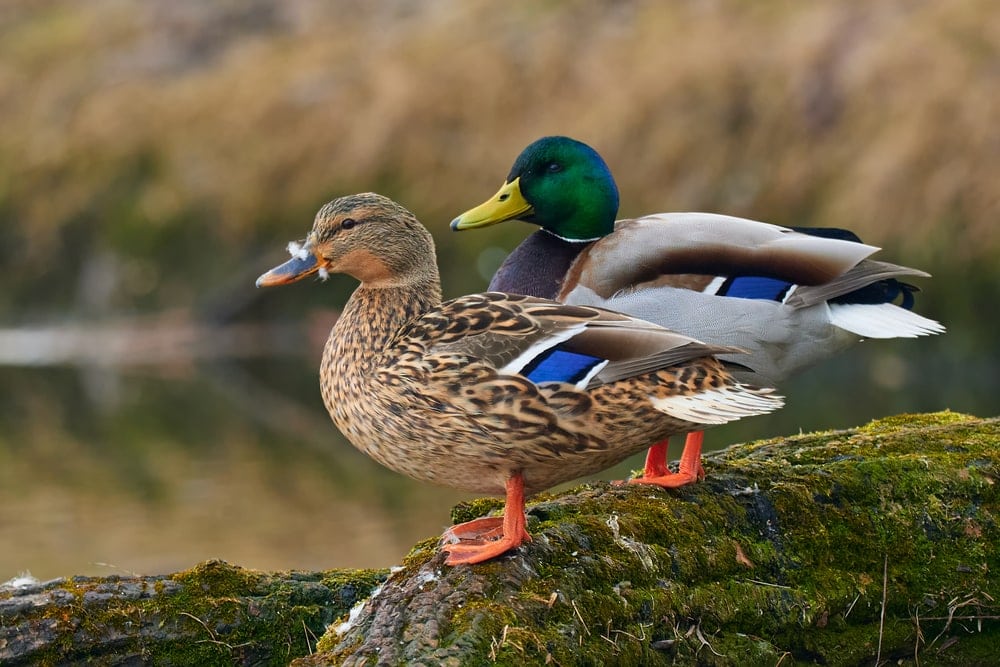
Of course, we can not leave out the mallard! One of the most recognizable ducks in the United States, mallards can be found year-round throughout the country. Mallards are located as far south as Florida, all the way up to Alaska. Mallards live in wetlands, ponds, lakes, parks, bogs – clearly, mallards are not picky about their habitat.
Mallards are foragers and eat both seeds and aquatic vegetation. During the breeding season, mallard ducks prefer protein-rich food such as larvae, earthworms, and snails.
Nesting takes place on the ground near the water’s edge. Natural nests tend to be in overhanging grass and made from anything the female can reach from her indentation of the earth. Female mallards will not carry material from anywhere else to their nest. Interestingly, mallards accept artificial nesting structures, such as homemade nests from homeowners and farmers. Mallard females lay 1-13 eggs 1-2 times each year.
Extremely distinctive, male mallards have green heads, a white ringed neck, chestnut-brown chest, and yellow bill. Their sides are gray and brownish-black. You can also spot violet-blue colors on the male, along with his coral-red feet. Males have notable curly tail feathers. Females are a mottled brown color with a dark brown crown and a dark brown stripe that runs through the eye. A female’s bill is orange with brown, and her feet are orange.
The mallard duck is the ancestor of almost all domestic ducks, even if they look much different.
Northern Shoveler
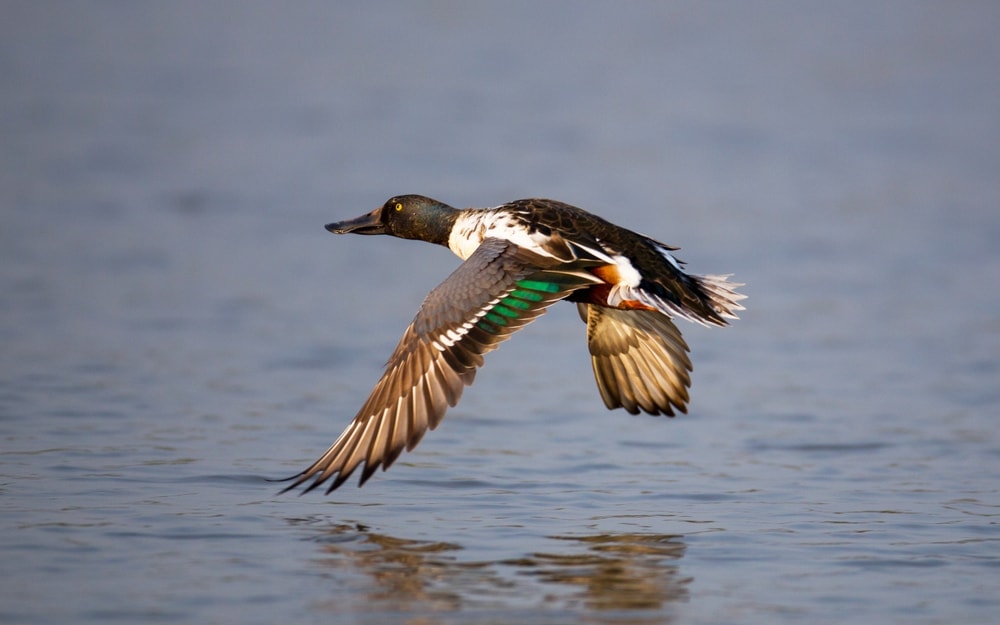
During the breeding season, the northern shoveler lives in the western regions of Canada, Alaska, and the northwestern United States, but not on the coast. The northern shoveler will then winter to the southern United States and Mexico, including fresh and brackish marshes and ponds. They tend to avoid full saltwater ponds and the open sea.
The northern shovelers live in shallow wetlands that have vegetation for hiding and feeding. Nests can be found in grassy fields nearby. During wintering seasons, these ducks forage in salt marshes, lakes, wetlands, and ponds. Females lay 8-12 eggs once a year.
The northern shoveler, known for its distinctive flat bill, filters out its food using lamellae or comblike pieces on the edge of its bill. They feed on small crustaceans, aquatic invertebrates, and seeds.
Breeding drakes boast a white chest, dark emerald green head, and a large black bill that looks much like a shovel. When stationary, males have reddish-brown sides but green and have a powder blue shoulder patch when in flight. When males are not mating, they look similar to a female in that they change to having brown markings.
Female northern shovelers have a marked brown head and body with powdery-blue shoulder patches. Matching the males, hens have an overly long and wide bill that is orange in color, matching their orange legs. These ducks use their overly sized bill to shovel and sift through the mud.
Black-bellied Whistling-Duck
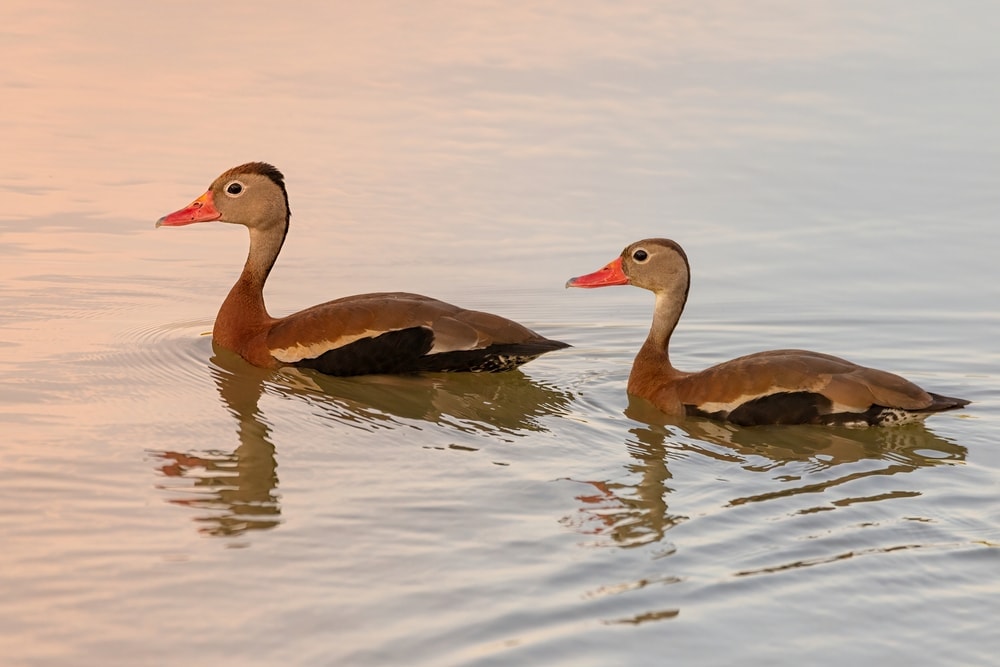
Black-bellied whistling-ducks live year long along the coast of Mexico, Texas, Florida, and South America. Like mallards, black-bellied whistling-ducks take well to handmade nesting boxes. You can find these ducks nesting in thickets of trees. They forage in fields, lawns, and shallow, freshwater ponds.
Often seen in farm fields, these ducks can eat sorghum, millet, corn, rice, and wheat. However, they mainly eat smartweed, grasses, amaranth, bindweed, and nightshade. Along with this, they eat small aquatic animals. Typically, they feast at night.
Much like the wood duck, black-bellied whistling-ducks nest in tree hollows. Both males and females pick the nesting site. Typically, these ducks do not build up their nests and instead lay their eggs on whatever is in the tree or nest box. Some wood ducks nest on the ground. Females lay 9-18 eggs 1-2 times a year.
Black-bellied whistling-ducks are unique in that males and females look the same. Both flaunt long necks with red bills. As their name suggests, they have a black belly with a chestnut body. A large patch of white on their wings can be seen either at rest or in flight.
Whistling-ducks do actually whistle, and a flock of these ducks will be extremely noisy.
2. Diving Duck
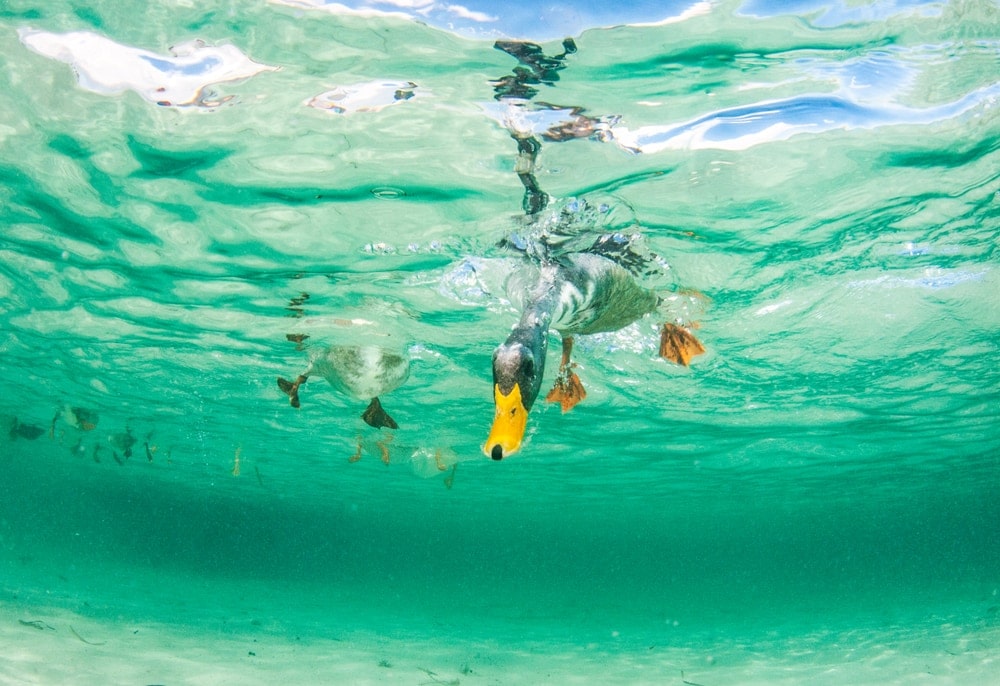
As their name suggests, diving ducks dive beneath the water’s surface to find food. Diving ducks dine on fish, insects, and aquatic plants.
Diving ducks, also called sea ducks, can be found in large, deep lakes, rivers, and coastal bays. There are roughly 20 species of diving ducks. Northern species of diving ducks will migrate, but north species do not.
Diving ducks are most commonly seen in water because they are less comfortable on land due to their far-back legs. When taking off from the water, you will hear their rapid wingbeat patter along the water surface. While their blunt-shaped wings mean take-off is a bit difficult, diving ducks are strong fliers once in the air.
Types of Diving Ducks
Bufflehead
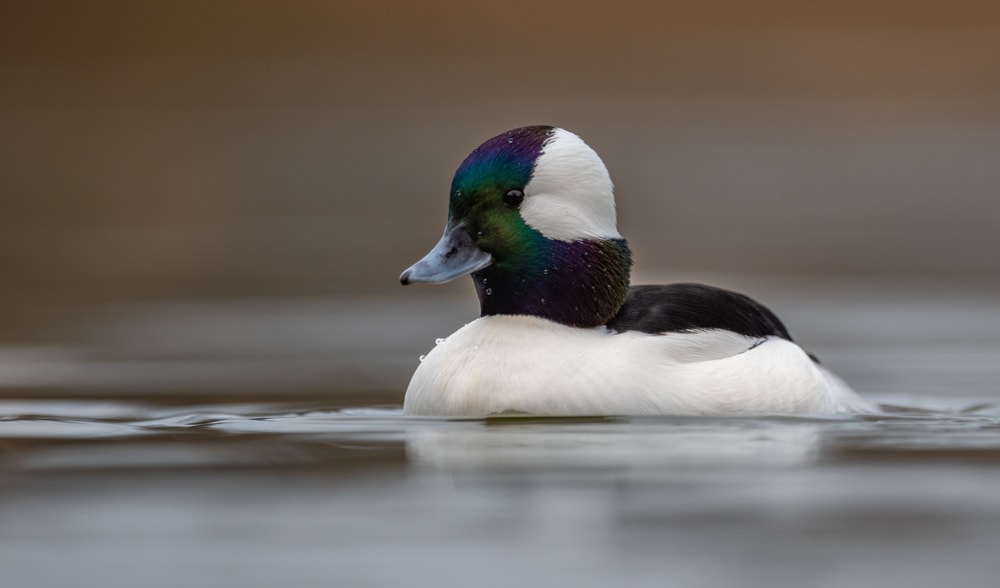
The buffleheads breed in southern Alaska and throughout central Canada. Buffleheads migrate along the coastlines and winter in the eastern United States. Half of the bufflehead ducks’ time is spent foraging underwater, looking for food. When they find crustaceans or invertebrates, they will eat them while still underwater.
A dive can last from anywhere between 12 seconds to 25 seconds.
Bufflehead ducks will only nest in tree cavities near ponds and lakes made by Northern Flickers or Pileated Woodpeckers. While these ducks stay on the coastline, they stay away from the open coast and keep sheltered coves, harbors, and estuaries. Females will lay 4-17 eggs per year. You will not see the bufflehead duck walking on land.
To dive deep into the water, buffleheads squeeze their wings and plumage close to their body to release any air, then give a small leap forward and plunge downward.
Buffleheads are very small with large heads. They have short, broad bills. Males have a white body, black back, and a white patch that wraps around the ducks’ dark heads. Female buffleheads are brown with the same large rounded head. They have a single patch of white on their cheek, and they have a fluffy appearance to them.
Canvasback

Canvasback ducks breed in western Canada and into Alaska while they winter into the mid-Atlantic United States. The Chesapeake Bay houses many wintering canvasbacks. These ducks search for brackish bays and marshes with lots of vegetation.
Plants, rhizomes, tubers, mussels, and insects make up a canvasbacks’ diet. To eat their aquatic plants, canvasbacks dive up to 7 feet (2.13m) below the surface. The ducks take insects from the water’s surface, instead of diving for them. Canvasbacks seldom go on dry land and will even sleep while floating.
Females will nest in shallow wetlands among the cattails and reeds. Most times, canvasback ducks make their nests on floating vegetation! Sometimes, female ducks will lay their eggs in other canvasbacks’ nests. Likewise, Redheads and ruddy ducks will lay their eggs in canvasbacks’ nests as well.
Canvasbacks are often seen in groups of thousands, gathering to be social. When flying, they can get up to speeds of 56 mph (90.12 kph)!
Both males and females are large and have a broad sloping forehead, with short necks. Both have white bodies and black chests, although females are more muted in these colors. Male canvasback ducks have bright red eyes, while females have black eyes with a tan ring around them.
Ruddy Duck
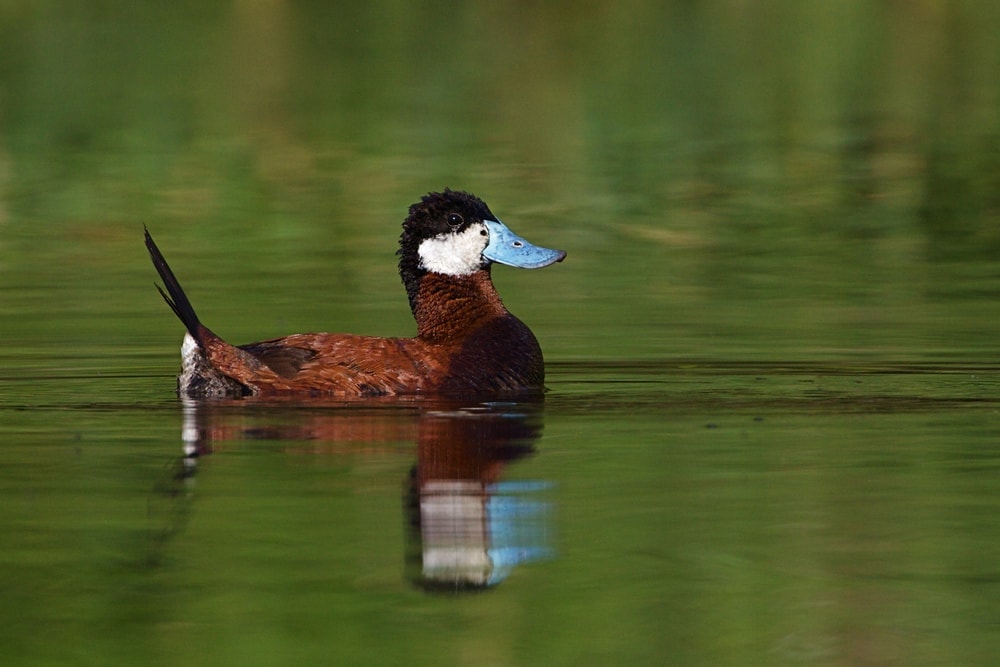
An absolutely adorable duck, the ruddy duck can be found throughout the United States and into Canada while breeding. You can find Ruddy ducks in both open water and on protected coastline. They thrive in wetlands during mating season.
Making this duck unique all on its own, males are bright blue-billed, white-cheeked, with a black crown. They boast a stiff black tail that sticks out of the water. The bill of the females resembles the shape of the males. It is a soft brown with a scooped shape. Both males and females have extremely thick and short necks.
To mate, male ruddy ducks beat their bills against their necks and bodies, pushing air into the water creating bubbles. This display will attract females who will then hear the male make a call similar to a belch.
Redhead
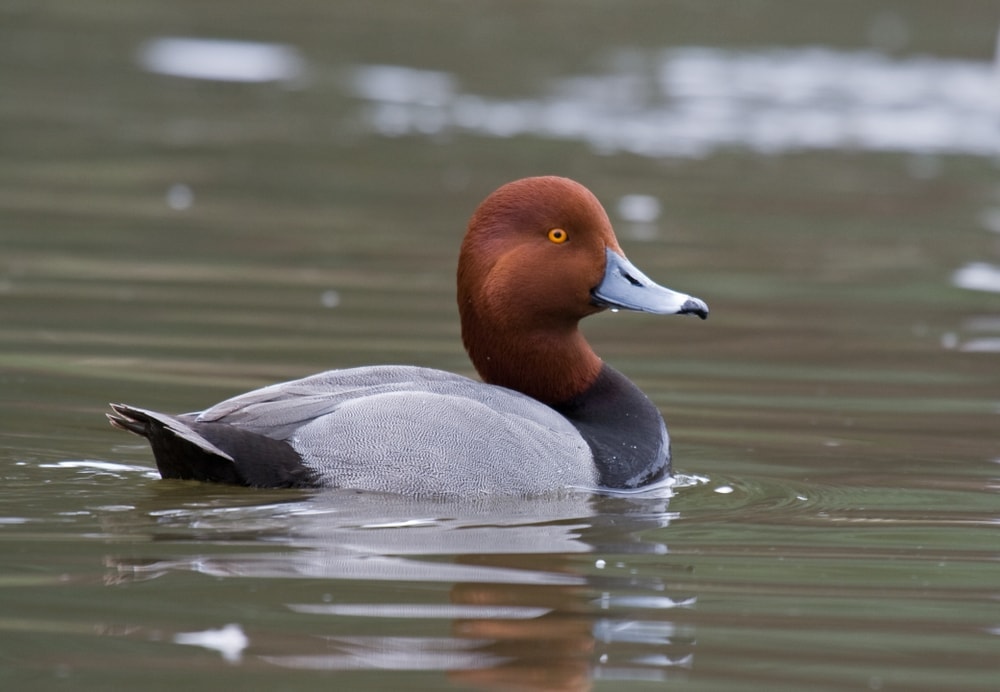
Redhead ducks breed in the northern Prairie lands of the United States, wintering south into the US and Mexico. They prefer marshes and open land deep lakes.
Redheads eat aquatic plants, pondweed, and grass. They also like to munch on snails, zebra mussels, and mayflies.
As their name suggests, male redhead ducks have a red head and a red upper neck. The majority of the male redhead’s body is black, with a dark gray color on its lower back. Male redhead ducks have bright yellow eyes, which stick out in contrast to their copper redhead. Its beak is light gray with a black tip.
Redhead females often lay their eggs in other birds’ nests, known as “brood parasitism.” These ducks do this because they rely on other bird species to raise their hatchlings. If females do hatch their eggs, they choose nesting sites within cattails.
Common Goldeneye
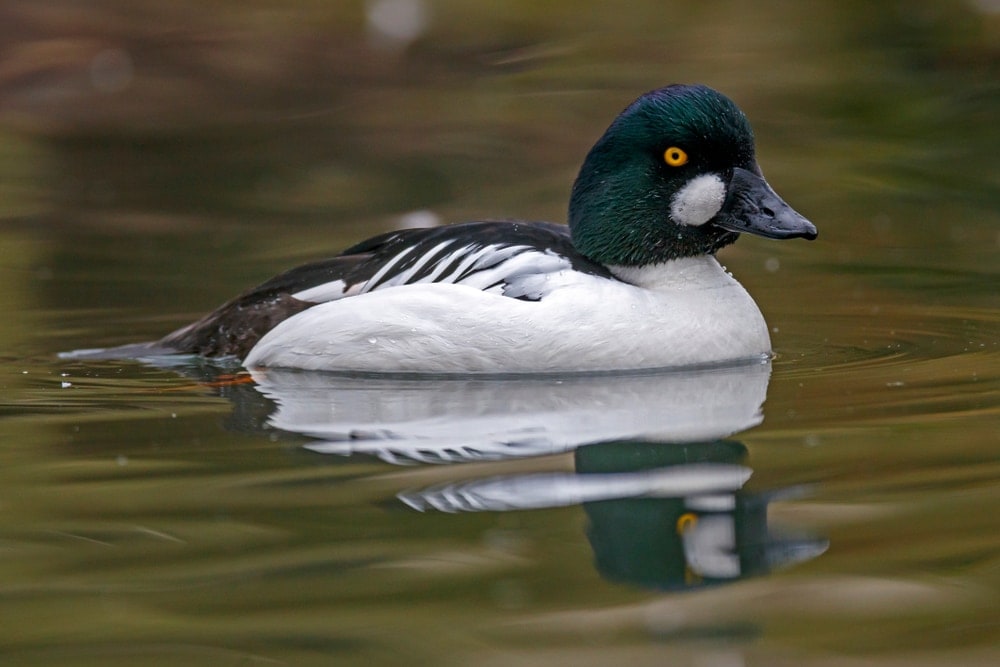
Common goldeneye ducks are large-headed ducks that eat mostly fish. Both males and females have bright amber eyes, hence their name, goldeneyes. Goldeneyes live in the forests of Canada and Alaska.
Goldeneye ducks feast on fish and fish eggs while supplementing with tubers and seeds. They also like to eat crabs, shrimp, crayfish, barnacles, and mussels. Goldeneye ducks synchronize their dives with each other and can last up to a minute underwater.
Like redhead ducks, females may lay their eggs in other ducks’ nests, especially those of Barrow goldeneyes. If females do nest, they do so in tee holes near water. Females will insulate their nests by plucking feathers off of themselves. Often, these ducks will return to the same nesting area year after year.
Hooded Merganser
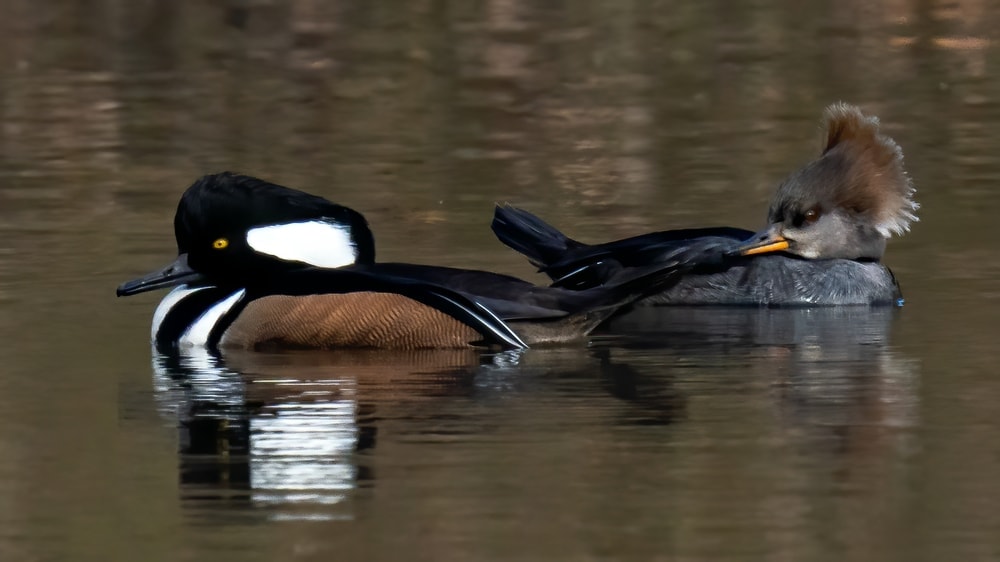
Hooded merganser ducks can be found in wooded wetlands from Alaska, down the west coast, and along the east coast, inland just past the Mississippi river.
These ducks dine on small fish, crayfish, and aquatic insects. They will supplement with vegetation, unlike other merganser ducks.
Females nest in tree cavities 10-15 feet (3.04 m-4.57 m) away from the water’s edge and 50-90 feet (15.24 m-27.43 m) up. Hooded merganser ducks will reuse nests from the previous year and/or will scout out new nests for the following year. After only 24 hours of hatching, baby merganser ducks will leave their nests, fluttering down 50-90 feet (15.24 m-27.43 m) or more.
Hooded merganser ducks, too, lay their eggs in other nests but only of their species. Some hooded merganser duck nests have had up to 44 eggs in them!
Male hooded merganser ducks are boisterous in their plumage with their oversized head, especially when they raise their hood or head feathers. Females can do the same but have more muted cinnamon tones instead of the sharp black and white of the male.
Red-breasted Merganser

Red-breasted merganser ducks live further North than the hooded merganser ducks. Commonly spotted in most of Alaska and the Bering Sea, they are as far north as the tundras of the Yukon territories. The red-breasted merganser ducks breed close to the coast in brackish and saltwater wetlands.
Red-breasted mergansers nest on the ground in all sorts of different vegetation and sites. These nesting sites are in marshes, rocky inlets, piles of driftwood, and vegetated islands.
Fish is the primary food source for red-breasted mergansers. They need to eat 15-20 fish per day, which means they dive underwater 250-300 times and forage for 4-5 hours!
Male and female red-breasted mergansers look like they’ve just been to a rock concert with plumage sticking out from the crown of their head. Males have black heads, red eyes, and white long necks. Their bodies are covered in black and white plumage and a red chest. Both males and females have a long, thin orange bill. Females have brown coloring on their heads and necks with gray and white bodies.
Greater Scaup
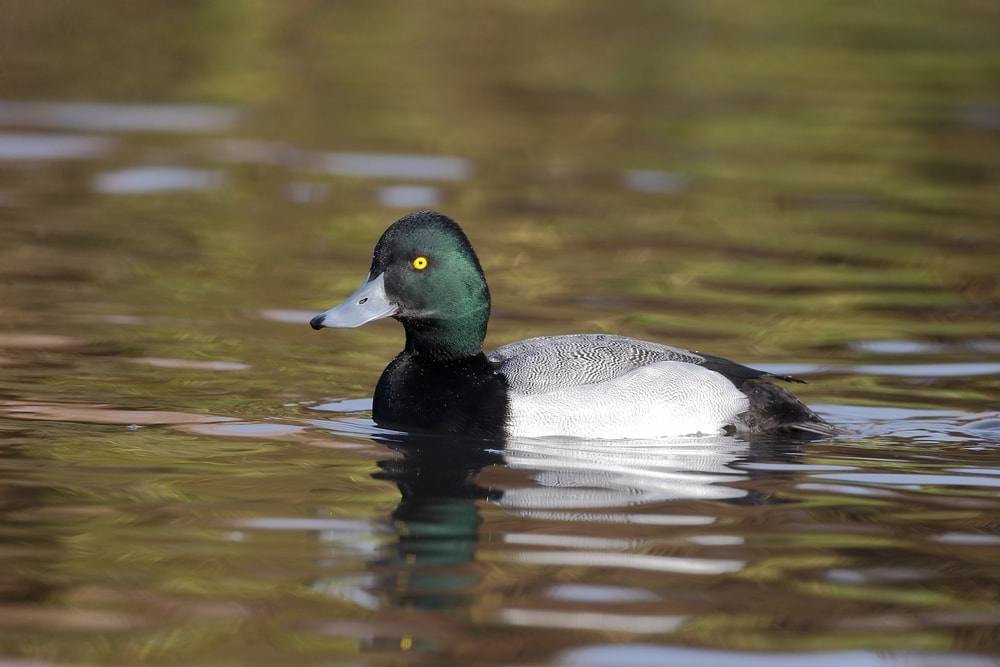
Congregating by the hundreds and thousands, the greater scaup duck lives in the tundra regions of North America and Europe. They breed in shallow lakes, ponds, and treeless wetlands. Liking diversity, greater scaup ducks like areas with shallow water for food, and areas with both out of the water and in water plants.
Greater Scaup ducks eat mollusks, insects, and crustaceans and will supplement with plants and seeds. These ducks dive up to 23 feet (7.01 m) for their meals.
Nesting happens either on high ground or on floating vegetation. Both locations keep the nests safe from flooding.
Harlequin Duck
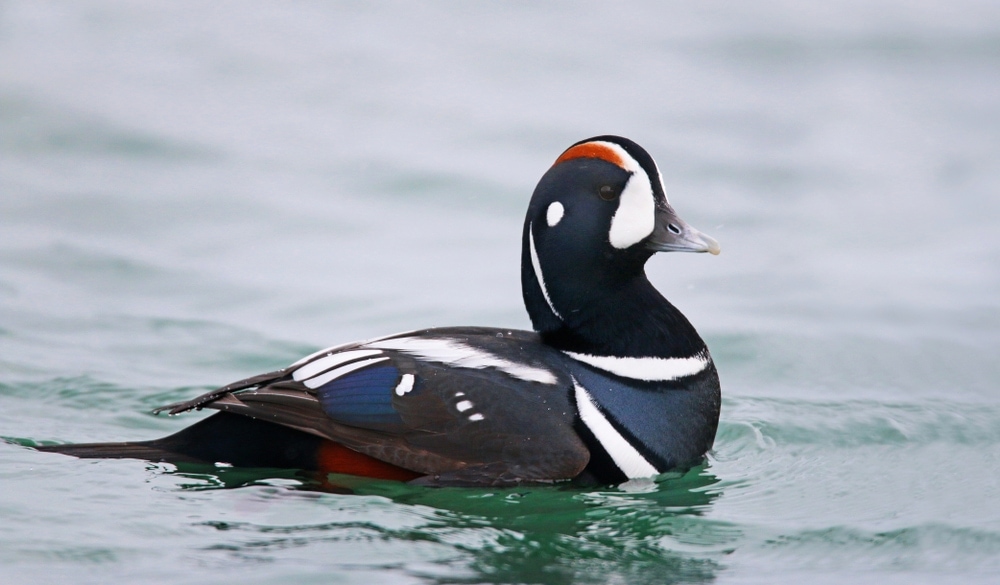
Harlequins are extreme to every level, from the males’ flamboyant plumage to their year-round natural habitat. These ducks live along whitewater rivers and endure rough water and high winds their entire life on the shores of the Pacific Northwest. In the winter, they move to the ocean’s shores and get tossed around in large waves against the rocky shore. It is common to see harlequin ducks with broken bones.
The harlequin ducks make a squeaking noise, much like a mouse. They live mainly on small fish and sea insects, along with fish eggs. Harlequins will dive down an astonishing 70 feet (21.33 m) for their meals and bring most of their food to the top to eat.
Nesting happens on cliff ledges in small nooks and crannies, along with holes in trees. Occasionally, a nest is on the ground.
Both males and females have small gray bills. Males, however, have an extravagant plumage with a slate blue body, white crescent behind their eyes, and a chestnut crown patch. Along their body, you can see bright red marks, along with long stripes of white coloring. Females are brown in shade with a distinctive facial marking of a white patch next to their bills and a white spot next to their eyes.
Black Scoter
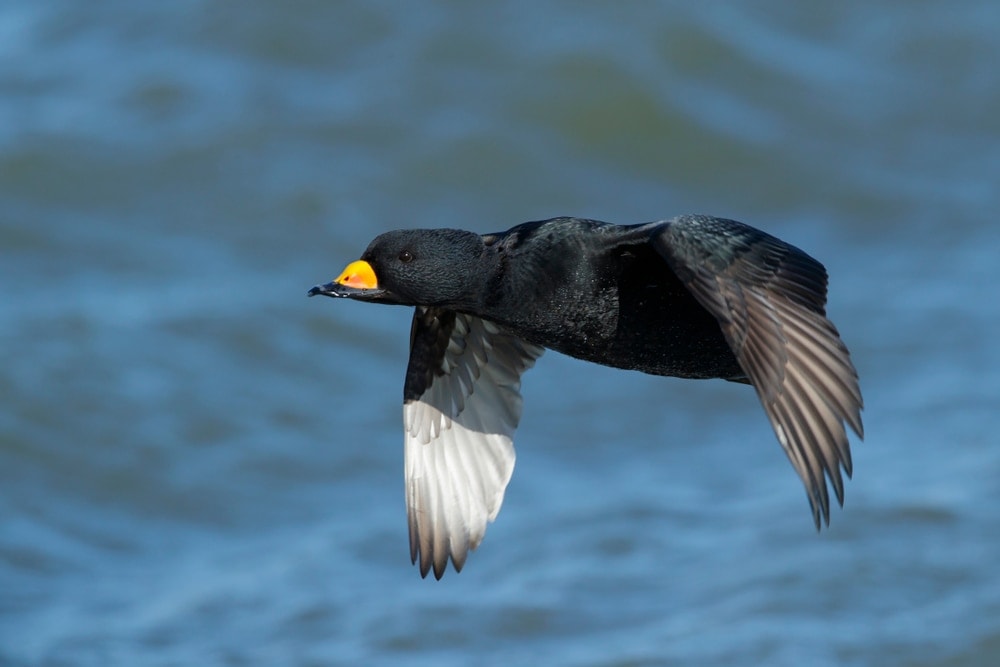
The black scoter duck is a sea duck that lives along both the Atlantic and Pacific coasts. They prefer shallow bay water, where they can hunt for mussels and other shellfish.
Nesting happens within 100 feet (30.48 m) of the coastline and is on the ground or on small trees. Courting between male and female black scoters includes a show from the male, which includes flicking water with their bill, shaking their head side to side, and doing impressive take-offs and landings in the water.
Male black scooters are medium-sized and completely black except for a bright yellow knob on the top of their bill. Female black scoters are an all-over dark brown but sport a pale face. They do not have the yellow knob.
3. Perching Duck
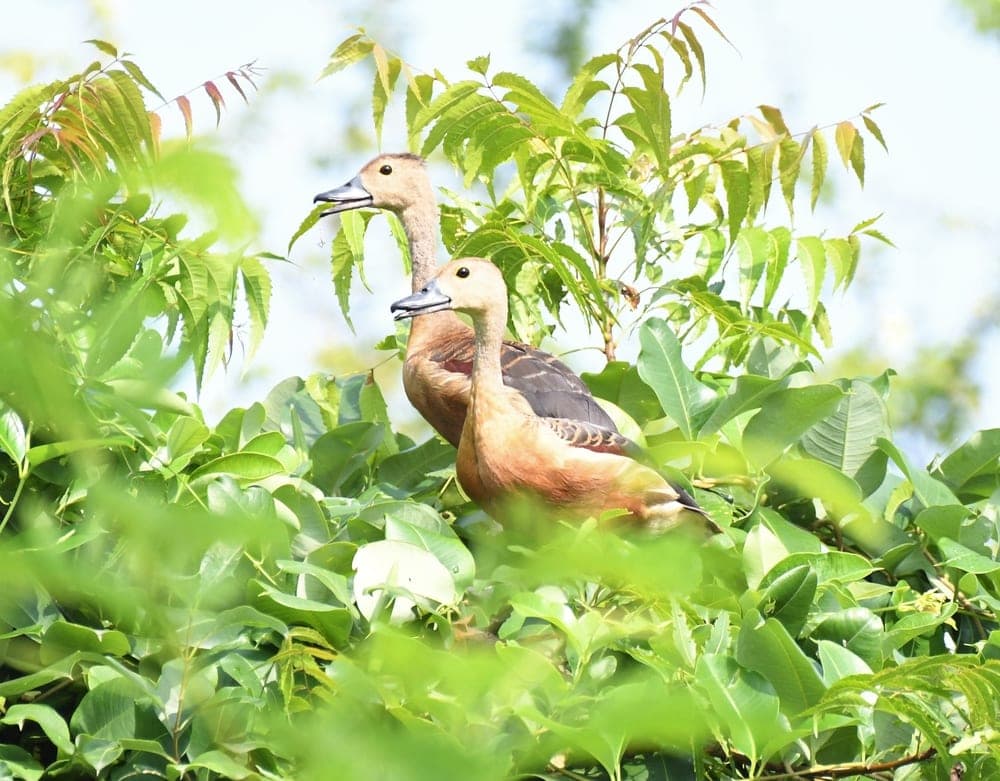
Perching ducks are found in the tropics in wet woodlands. They are known for nesting in tree holes and perching high on branches, giving them their name. They have long claw-like toes that help with perching.
Larvae, snails, crabs, and aquatic animals are favorite meals for perching ducks.
Perching ducks boast bright colors with white wings and black linings. Drakes are larger and more colorful than hens, much like dabbling ducks.
Types of Perching Duck
Blue Duck
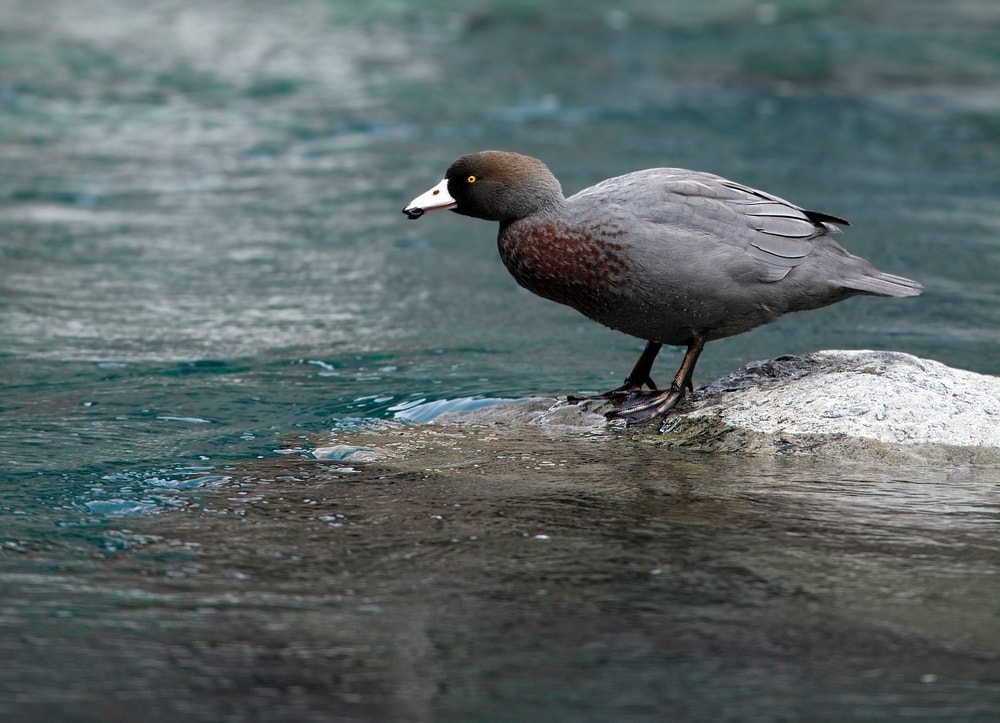
The blue duck has bluish coloring mixed in with chestnut speckles and lives in New Zealand. They stay near fast-flowing rivers in the mountains. They are powerful swimmers and do not fly much.
Blue ducks nest in hollow logs and small caves. Hatchlings are born with adorable tiny green beaks, but they develop an adult coloring after about eight hours. Adult bills are white-pink with black flaps that hang from the sides of the tip.
Torrent Duck
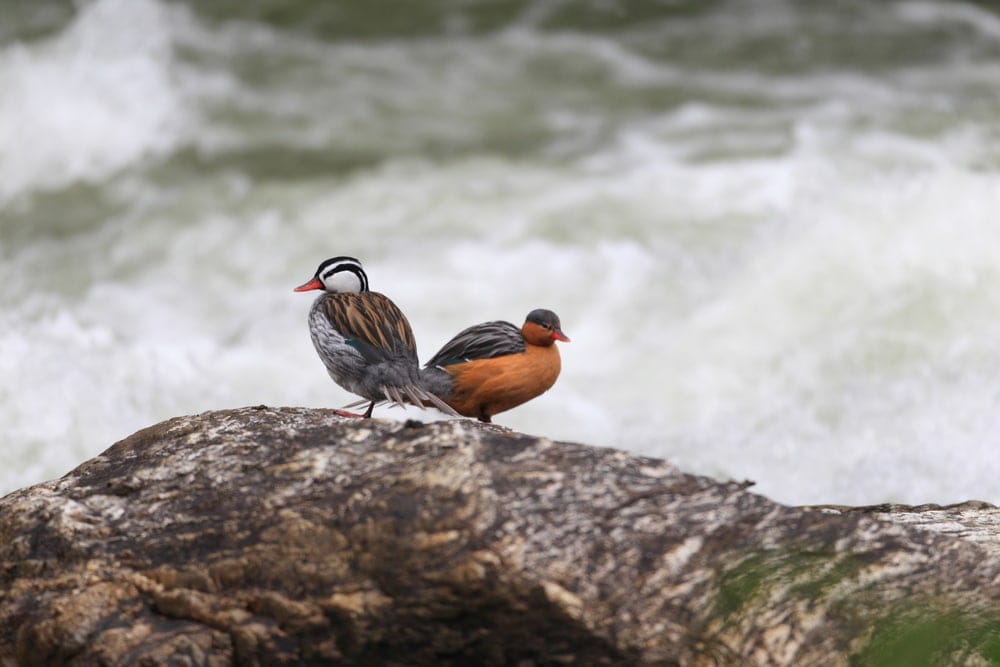
Found in the Andes of South America, torrent ducks live at elevations of over 5,000 feet (1,524 m). They prefer fast-flowing mountain rivers and are strong swimmers. They only fly for short distances to their nests.
Male torrent ducks have brown and white ‘streaks’ marking their chests and backs. They have black markings that are a teardrop shape from their eye and stripe down onto the backs of their necks. Female torrent ducks boast a chestnut-brown chest and a brown and white striped back. Both males and females have a dark orange beak.
Brazilian Duck
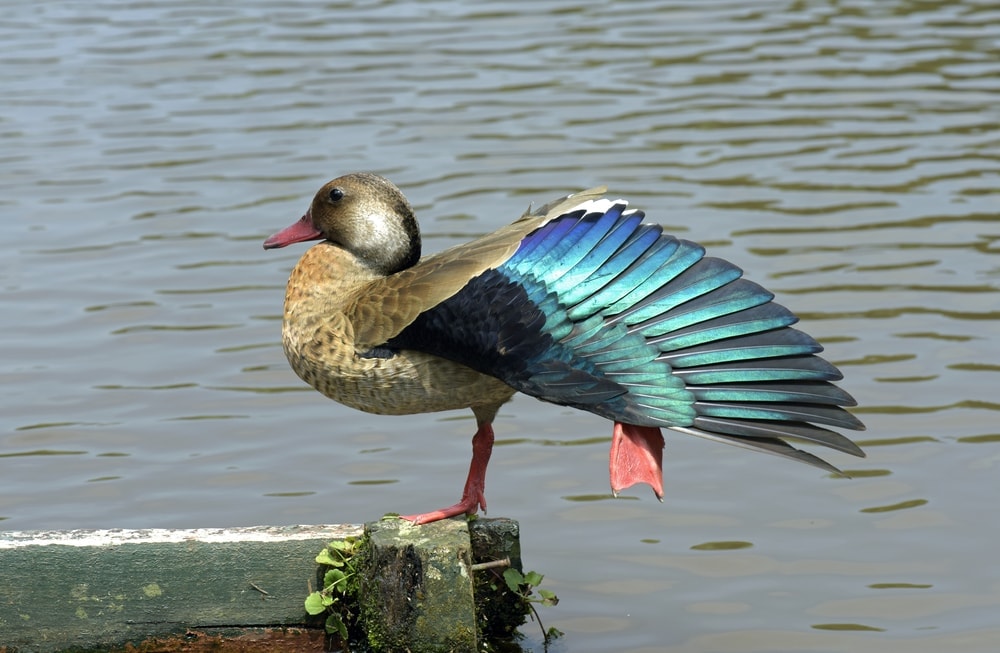
Found in South America, Brazilian ducks have the most fantastic plumage when in flight. Brazilian ducks prefer freshwater with lots of vegetation. Unlike most ducks, both male and female birds look after hatchlings.
Brazilian ducks prefer to stay in groups of 2-20.
While resting, Brazilian ducks have brown plumage. The male duck boasts a bright red bill, while the female ducks have brown bills. However, you will see the most amazing teal plumage on these ducks’ wings when in flight.
Comb Duck
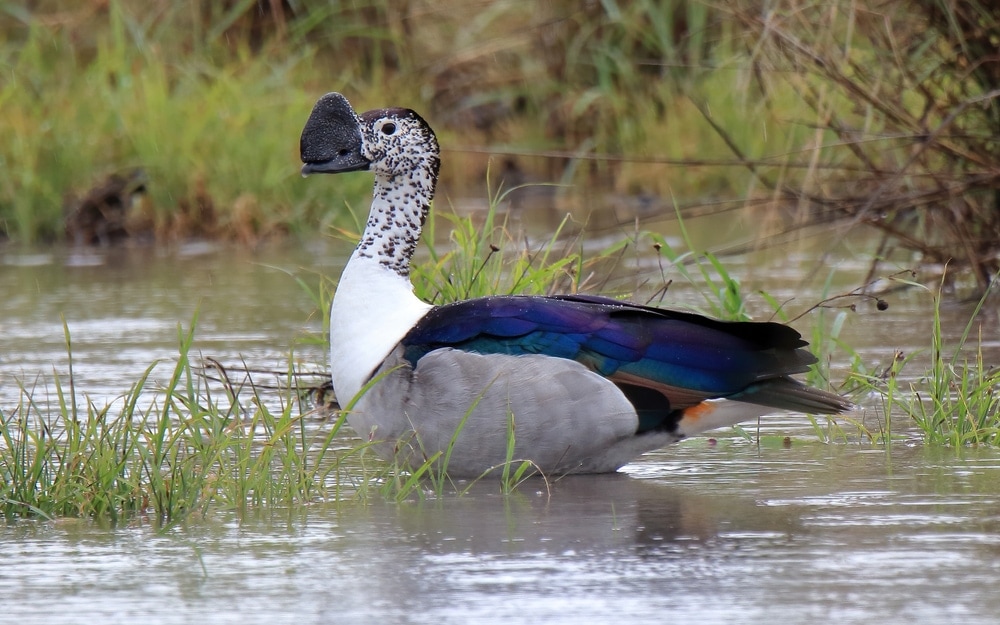
Also known as knob-billed ducks, the look of the comb duck will knock your socks off. Comb ducks have a large black knob that sits on the top of their bill, making this duck unique! Adults have freckled black and white heads, a white neck and chest, and a dark body.
Comb ducks live in South America along with sub-Saharan Africa, Madagascar, and South Asia. During the dry season, up to 100 comb ducks can be seen scavenging together, while in the wet seasons, they create smaller droves.
Pink-eared Duck
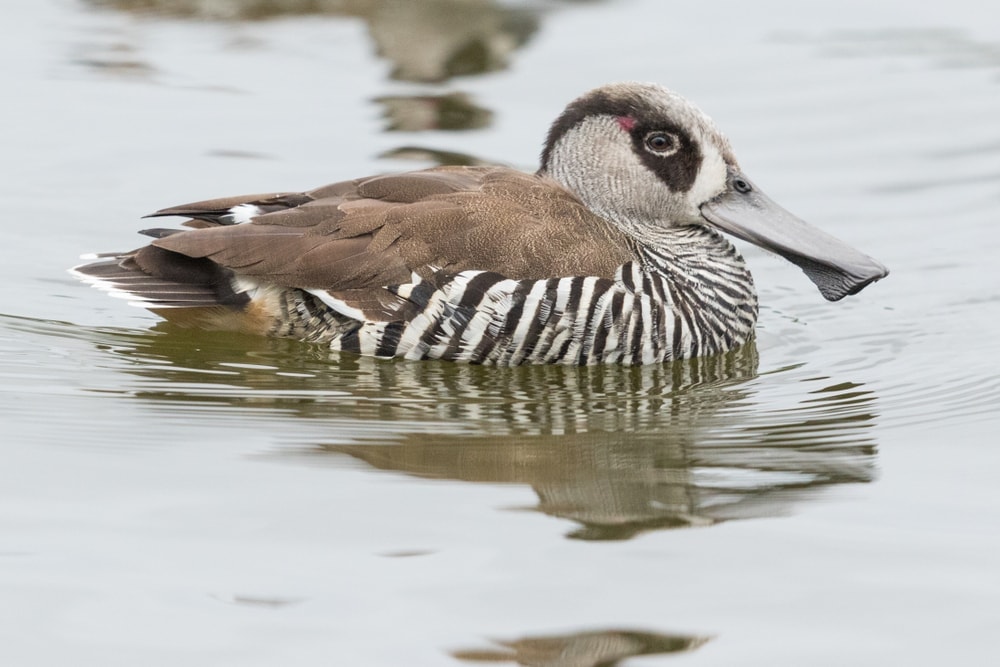
Found in Australia, the Pink-eared duck has a distinctive spatula-like bill. This duck has a white head with black eye patches, a brown and white striped body. These ducks are often called Zebra Ducks because of their stripes. Their name ‘pink-eared’ comes from tiny pink rose-colored patches right above and behind their eyes. These pink patches are hard to spot unless you are very close to the duck.
Pink-eared ducks congregate in shallow flood plains, and nesting only happens when there is a lot of food in the area.
Hartlaub’s Duck
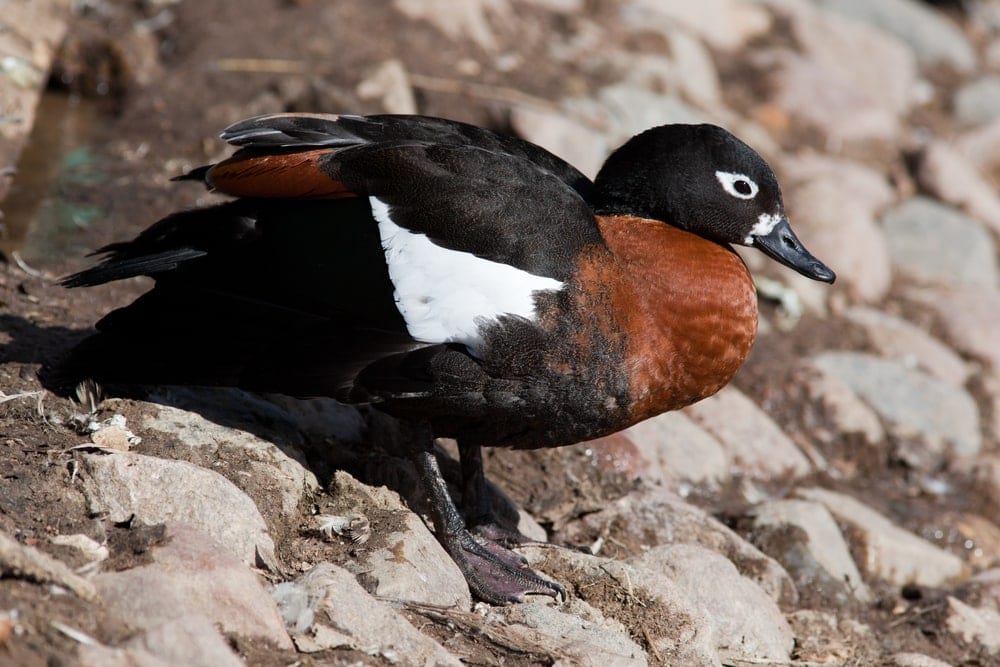
Hartlaub’s Duck is named after the German naturalist Gustav Hartlaub, who discovered the duck. They live in West and Central Africa, from Guinea to Sudan.
Hartlaub’s Ducks have a very dark black head with white speckles on its crown. The rest of its body is a dark mahogany brown. They boast a beautiful light cornflower blue stripe on their wing.
Cotton Pygmy Goose
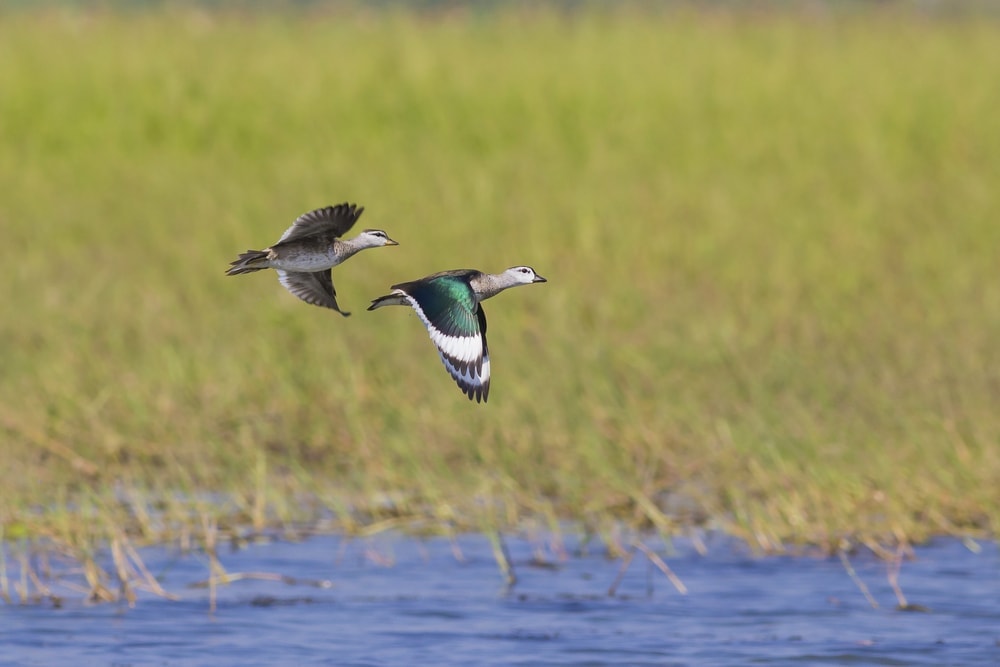
Also referred to as cotton teal, the cotton pygmy goose is a small duck, despite its name. These ducks live in India, Pakistan, and Southeast Asia. Australia is also home to these ducks.
The cotton pygmy goose nests in tree holes, like hollowed-out trunks, during the dry season. They swim in freshwater lakes, paddy fields, and irrigation tanks.
When males are breeding, they boast a white head and neck and show green and white wings when in flight. They have red eyes and a black band around their lower neck. Females do not have this collar and only have a narrow strip of white on their wings.
Mandarin Duck
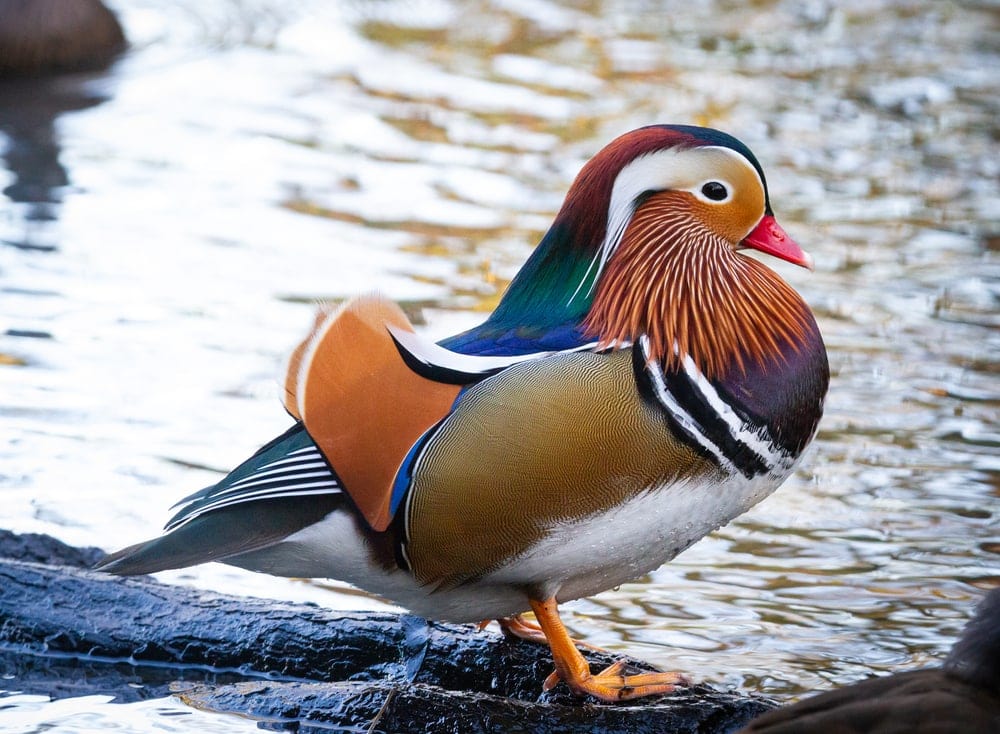
This medium-sized duck boasts beautiful plumage of many colors. Mandarin ducks, also referred to as Yuan-yang by the Chinese, are often featured in Chinese art and usually found in weddings.
The male mandarin duck has a small red bill with yellow cheeks, a dark black crown, and white crescents above its eyes. They have reddish “whiskers” that cascade down their neck. Their chests boast a purple color, and their backs are a beautiful tan with black and white outlines. Female mandarin ducks are brown with white speckles. They have an elegant white eyering and white tear-drop that falls down the side of their face.
Mandarin ducks can be found in wooded areas and prefer shallow lakes or ponds. They nest in trees close by. A few days after hatching, a mother hen will coax her hatchlings out of the tree stump by encouraging them to fall to the ground.
Mandarins walk on land and eat plants and seeds instead of in the water.
Ringed Teal
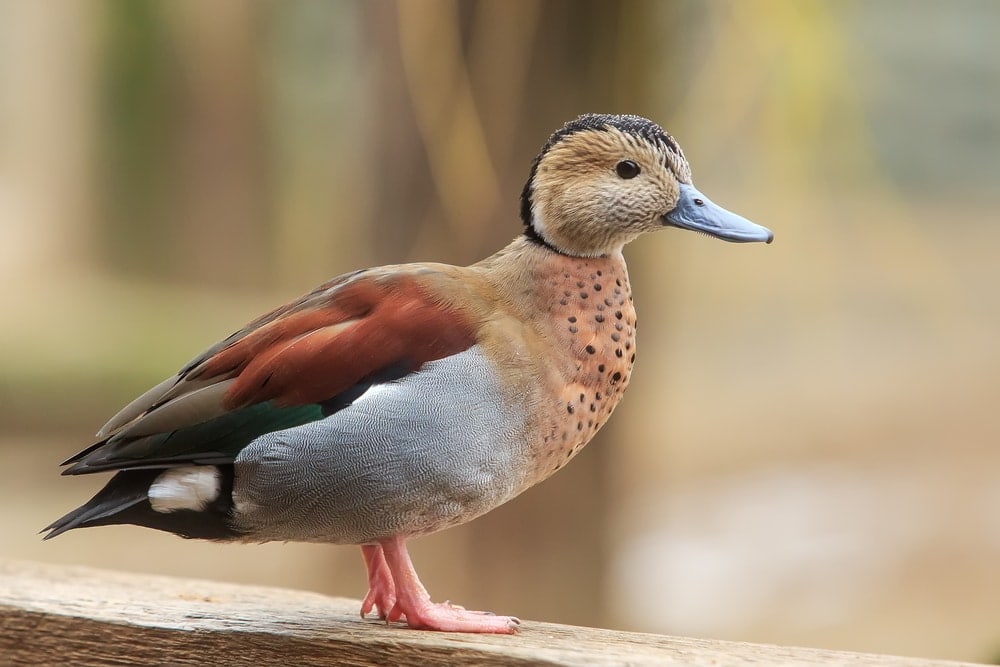
The ringed teal duck lives in South American forests such as Argentina, Paraguay, Bolivia, Brazil, and Uruguay. They live in swampy woods and marshes.
Male ringed teal ducks have brown and black speckled cheeks and heads, while the crown has a black stripe down it. Their chests are light brown with black polka-dots, and their back is black with reddish wing feathers. Females have a spotted white and brown head, a pale neck and belly, and dark brown wings. Seen in their resting state is a stripe of green on their feathers.
Female ringed teal ducks have a fascinating call that sounds like a “mee-ow!”
Maned Duck
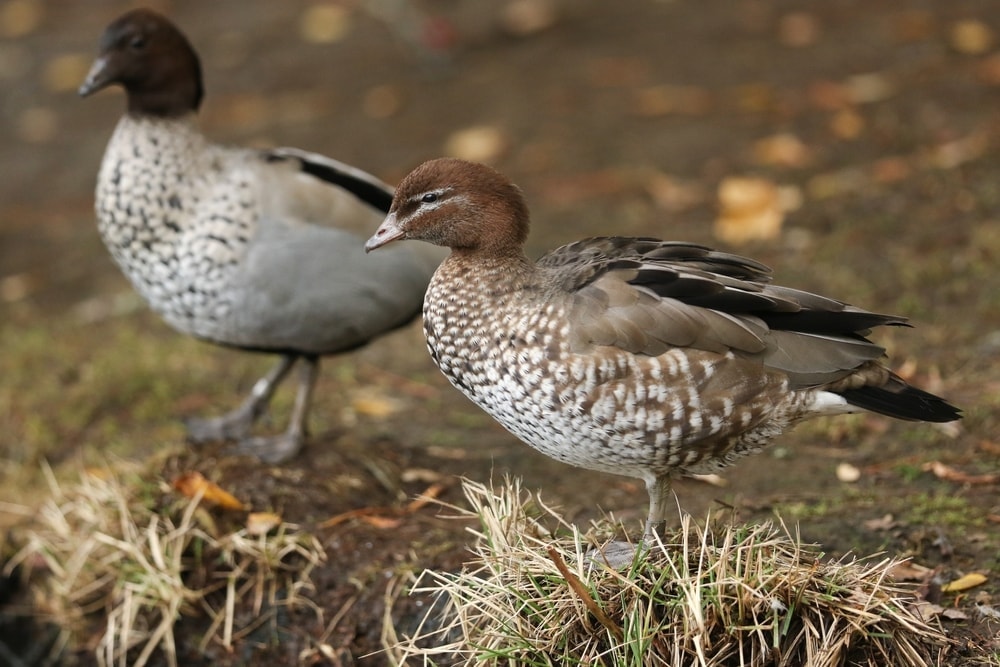
Found in Australia, maned ducks resemble a small goose. Both males and females look similar with brown heads and speckled brown and white chests and backs. Unlike most ducks, maned ducks barely swim and feed on dry ground. They search for plant matter.
Nesting for a maned duck takes place in tree cavities.
You may also like: Meet the 25+ Different Types of Falcon Species Found in the World: Complete With Images, Facts, and More!
Duck Life Cycle: Egg, Hatchling, Adult
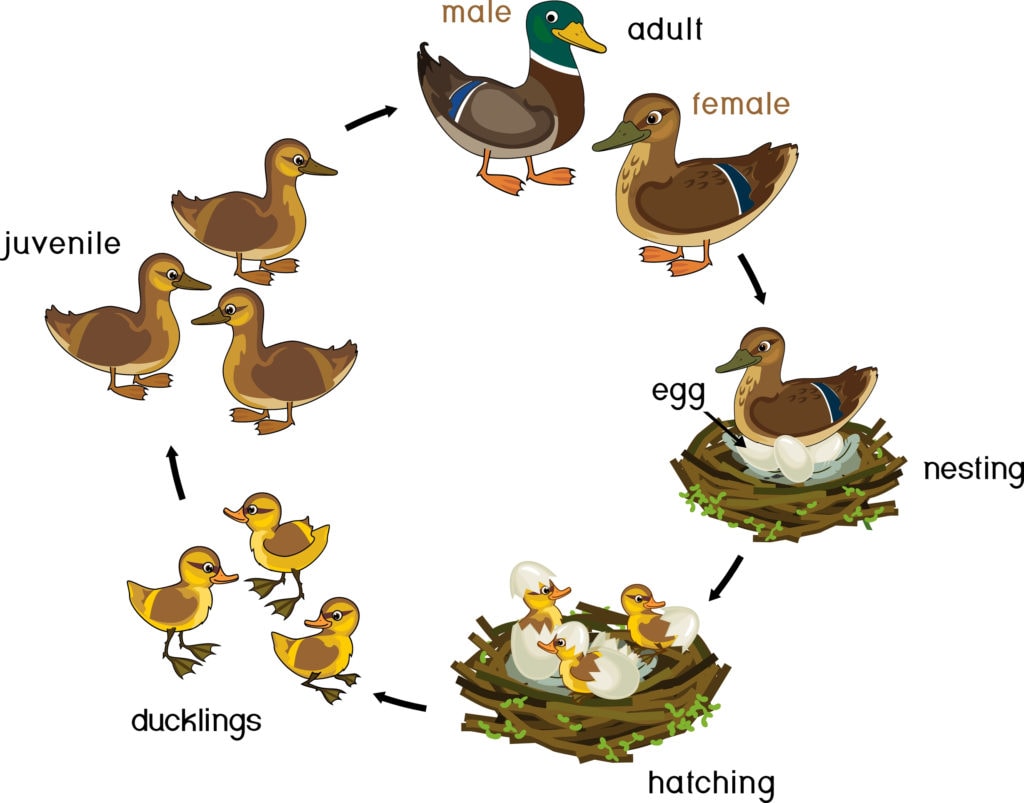
After a hen has found her drake for mating and laid her 5-12 eggs, the eggs will hatch within 28 days. For a little over a month, the mother duck keeps her ducklings together in a group. If you have ever seen ducklings out in the water, you will notice that they travel in a group or a line behind their mother and often stop to group back up.
After leaving their nest, hens and their ducklings do not return to their nest. Instead, the hen takes this time to teach their ducklings how to forage and hunt for food. The mother duck will snuggle her ducklings each night to keep them warm in her down feathers.
After 5-8 weeks, ducks are ready to fly and ready to leave the protection of their mother. At this point, ducklings molt and become juveniles. During this time, they will complete their first migration. Mother ducks may still assist with the first migration trip.
Within an entire year, ducks are fully grown with their adult coloring.
You may also like: Meet the 344 Amazing Types of Doves: Description, Images, Infographics, and More!
Interesting Facts about Ducks
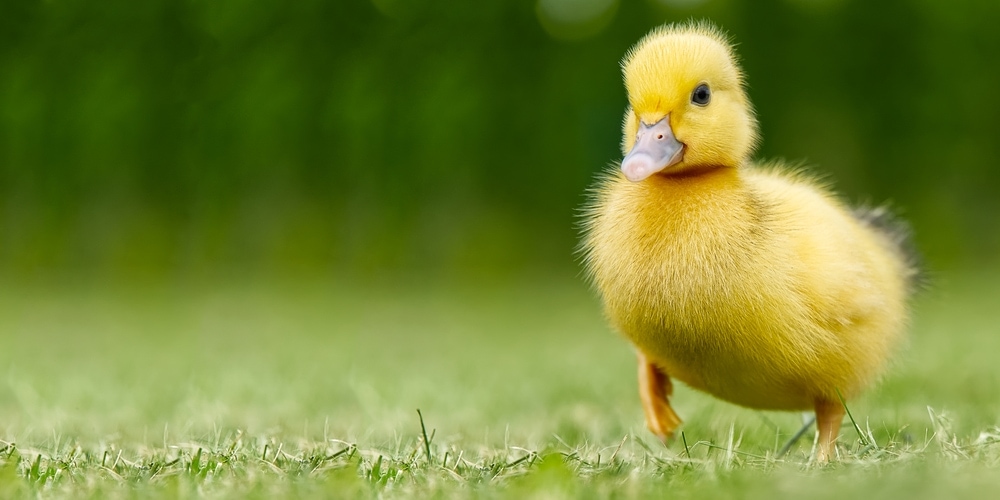
- Ducks live on every continent except for Antarctica.
- For over 500 years, people have been domesticating ducks for pets and farm animals. All domestic ducks descended from the mallard. There are now many different species of domestic duck breeds.
- Wild ducks can live for 20 or more years. The oldest recorded duck was a mallard at age 27.
- Ducks have webbed feet that do not have nerves, meaning they never get cold feet! No nerve endings allow ducks to swim and walk on cold icy water and snow.
- Like many aquatic animals, ducks have three eyelids. The third eyelid acts as a protective shield under the water, like goggles.
- Ducks’ feathers are waterproof. Ducks that boast denser feathers will have a dry underlayer of feathers after diving for food.
- If you have ever seen a duck digging his bill into his feathers, called preening. Preening is how ducks clean themselves, and they do it continuously throughout the day.
- Ducks are social creatures who prefer to be in their flock instead of alone. Most ducks spend the night sleeping together in a group.
You may also like: Get to Know More About the 14 Different Types of Birds of Pennsylvania: Complete with Images, Facts, Descriptions, and More!
A Duck’s Quack
Not only do ducks quack, but they also make various other sounds such as whistling, cooing, yodeling, and grunting. It is a common urban legend that a duck’s quack doesn’t echo. This has been proven false, much like other urban legends. The most distinctive quack that most recognize is typically the female mallards quack. Mallard males make more of a rasping sound. Listen to the variety of sounds these noisy mallards are making!
Also, listen to these diverse ducks making all sorts of sounds;
You may also like: Check out These 15 Fascinating Birds with Long Necks Across the Globe: With Images, Facts, and More!
Ducks Natural Predators
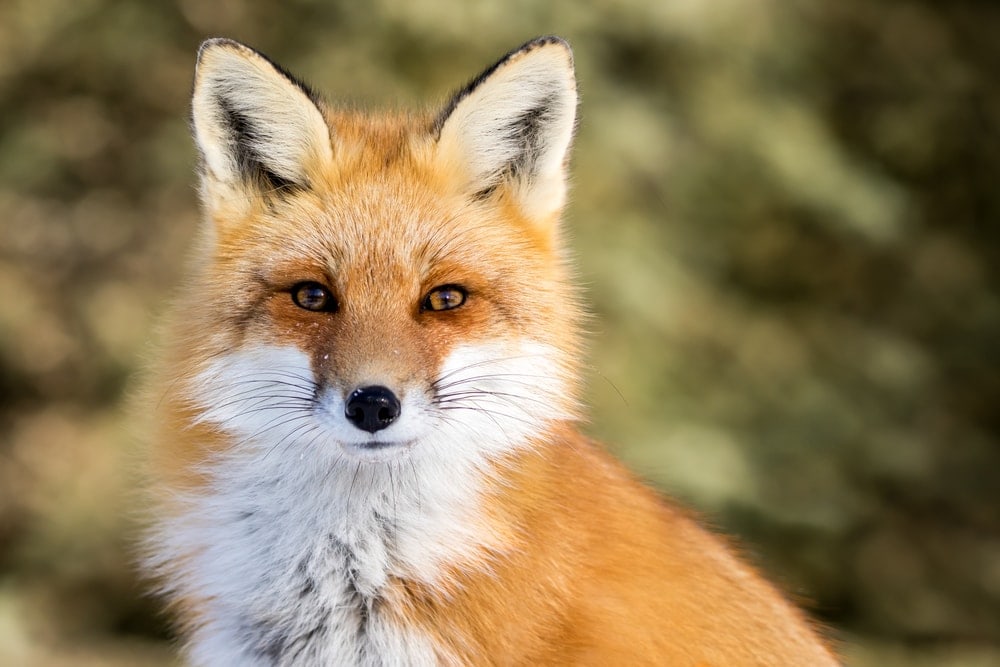
Ducks, duck eggs, and ducklings are always in danger of natural predators.
The key predators are;
- Red Foxes
- Raccoons
- Skunks
- Coyotes
- Badgers
- Mink
- Corvids
- Gulls
Not all of these predators would eat a full-grown duck, but instead, attack nests and eat duck eggs.
You may also like: Meet the 23 Different Types of Foxes and Where to Find Them: Description, Images, and More!
Navigation during Migration
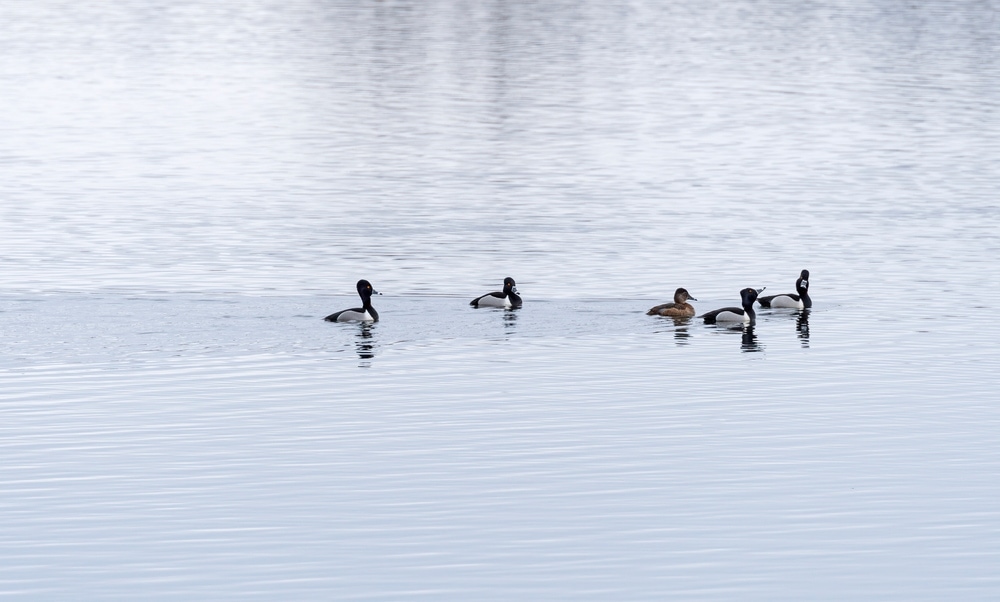
Birds use annual paths called flyways to migrate. However, scientists are not positive about how birds navigate their flyways.
Possibly, birds have an internal navigation system that allows their bodies to follow the same path each year. It is also possible that birds recognize the same areas and landmarks each year when migrating. Another theory is that a bird’s beak will lead the way in migration, finding its way with smell.
Birds may always know which way is North.
You may also like: Look at the 225 Majestic Types of Owls: Description, Facts, Images, and More!
Ducks FAQ
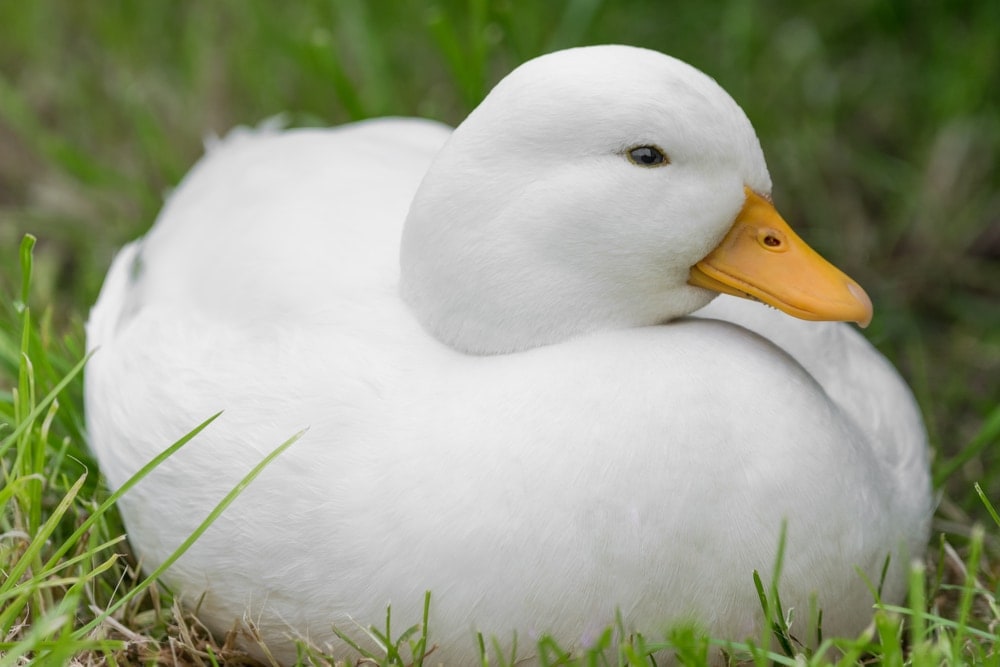
Are Geese and Swans considered Ducks?
What is the Classification for Ducks?
Ducks are in the class of Aves, Order of Anseriformes, and
Family of Anatidae
What is the Smallest Duck in the World?
The domestic call duck is the smallest in the world, weighing between 20 and 26 ounces (566.99 g-737.08 g), while also being absolutely adorable looking like a stuffed animal.








